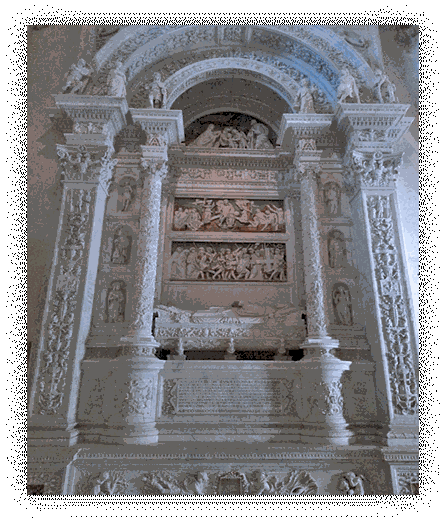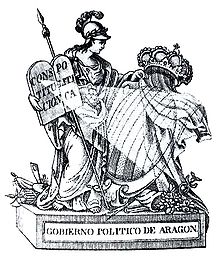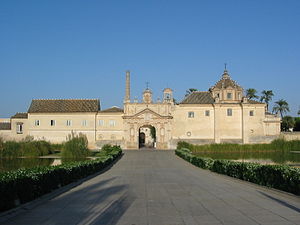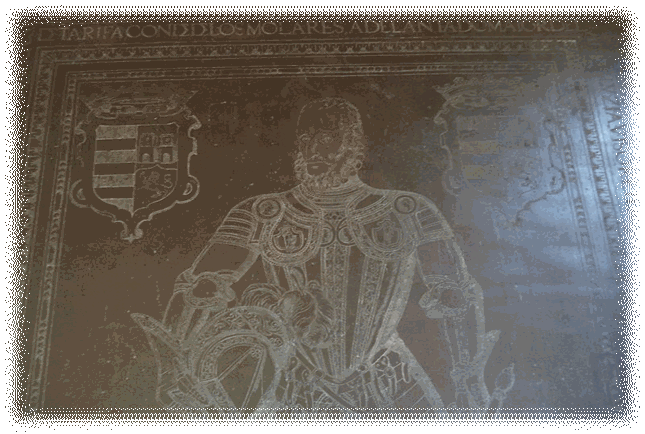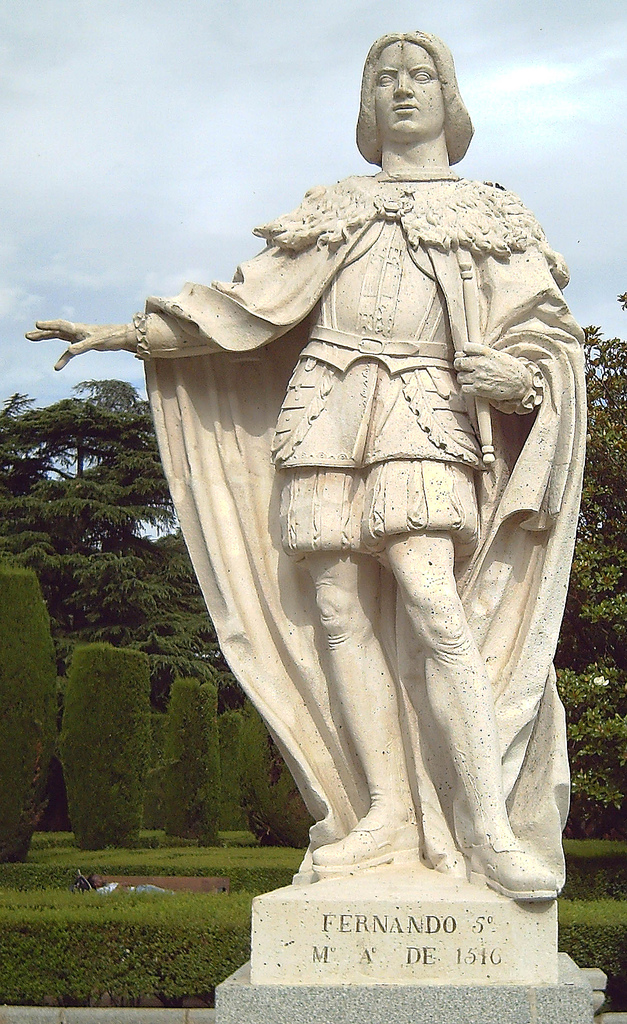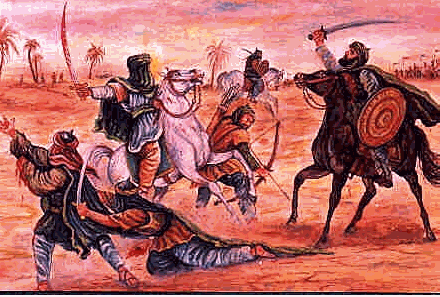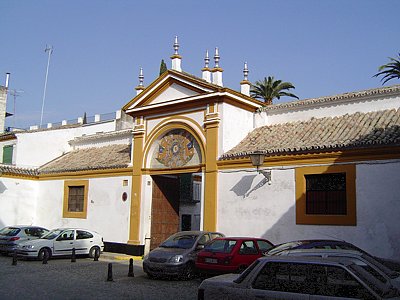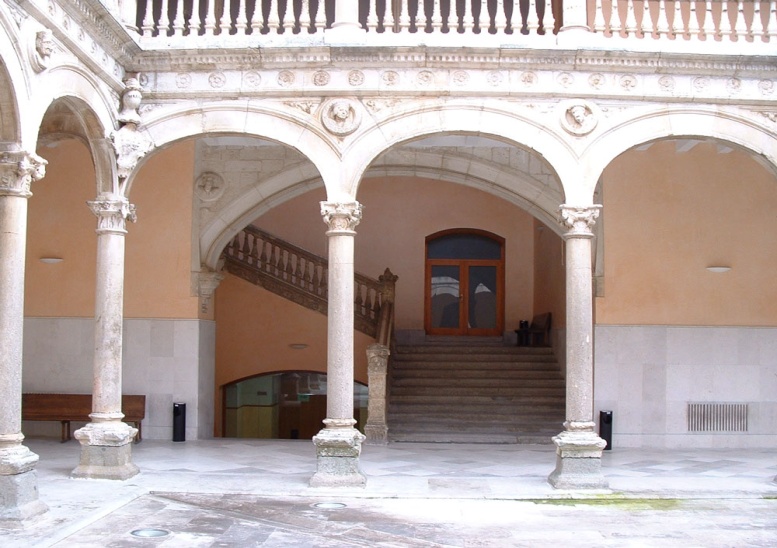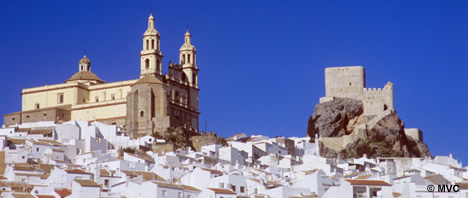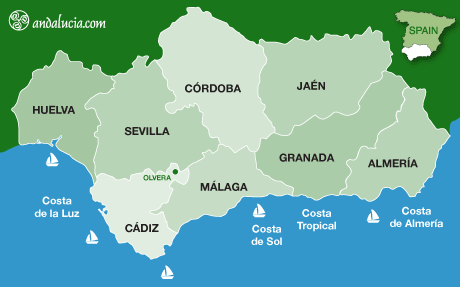|
Chapter Four The Old World Iberia, Pre-Spain
The search for one's family history is a labor of love. With enough research a family picture begins to emerge, almost bringing some ancestors back to life. One begins to see them as real people rather than ancestors whose lives are spoken of in print or just a face found in a faded photo. In time, I learned enough about some to feel as though I know them. The experience has changed my life and perceptions of family. They are now my family, thus my love for my ancestors, the de Riberas of New Mexico. My family's story begins in the fiercely fought over Iberian Peninsula, which was later to become known as Spain. It was forces beyond the control of any of the Iberian inhabitants that impressed a deep love of God, country, and honor upon their Spanish souls. Thus my mother, Angela Rivera (de Ribera), sprang from a long line of warring peoples that melded together into what are known today as the Spaniards. My mothers people were of ancient Iberians, Roman, Jewish (Sephardic), and the succession of other tribes that found their way to that beautiful peninsula. There they fought one another for possession of the land and its promise. Each tribe rose to power and gradually lost it to another. Hungry and determined to make the place their own in time they mingled their bloodlines until they became one common stock, todays Spanish. Mother's pride in her Spanish heritage, family, and its history was always a topic of discussion at the evening dinner table. That pride and love of family never left me. My genealogical search began with my maternal grandfather, Isidro Rivera (de Ribera) y Quintana. He was born in Pecos, New Mexico in 1870. Soon, the search included my maternal grandmother, María Anna Amalia Ceballes, originally Ceballos. She was also born in Pecos, on August 5, 1878. They were married in Pecos, New Mexico on January 25, 1898. As Mimi Lozano-Holtzman of Somos Primos fame has taught me, a genealogical project involves a passion for research, data collection, analysis, and documentation. The aforementioned are necessary and, at times, difficult. The result of the research process is a mountain of documents and notes. These records necessitate a filing system. Accessing a poorly developed system can overwhelm the researcher. As a result, an easily retrievable electronic database is suggested. This should be supported by well thought out file folder system or tabbed binders. The research process requires the development of a unique skill-set. These include the ability to review personal and legal documents with an eye toward linking them to one's family lines. It requires patience and sound judgment. Data collection is one of the building blocks of any research project. The documents often have misspelled and/or differently spelled names. The researcher will also find conflicting and incorrect dates for births, deaths, marriages, etc. He/she must integrate into family lines. Another very important skill is that of, "People Interfacing". Important leads are often found through others. In my case, it was the kindness of Michael Gallegos and Marcus Flores that often removed roadblocks and provided directions around the always-present blind alley. An added bonus is that these two men are newly found, long lost family. These wonderful people saved me countless hours of needless research through their kindness and efforts. Months into the project, I found a new group of friends. They are "The History Hunters", my fellow researchers, dedicated men and women with a love of family. This is a gift that I can never be too thankful for. They remind me of the tough minded Spanish, New Mexico settlers that are my family lines. Like the Spanish men and women who came to the Southwest and built lives and fortunes in a very unforgiving environment these history hunters never give up. The name Ribera is Spanish in Origin. It is first found in Castile, where it originally meant "riverbank". In time, it was used as a surname. In earlier times, it was often seen with the prefix "de", to indicate the place of origin of a family. Spelling variations of the name include Rivera, Ribera, Ribeira, Rivero, Ribero, Ribeiro, and others. Don Fernando Rivera of Santa Fe provided a Ribera Coat of Arms. It's depicted by a green shield with three horizontal red stripes. This chapter will introduce the reader to these hardy peoples, Iberians who melded into what would become the Spanish. These would later settle the Spanish New World. To know who they were and what they were about is important. It provides the reader with an understanding of what motivated them, what drove them to leave the comfort of Europe and its traditions, and to venture outside to the world of the unknown.
What is a Spaniard?
I provided a primer in "Chapter One" in an attempt to ease the reader into some understanding of this complex subject, Spain and its people. Most of us are limited in our knowledge and understanding of the human race, racial groups and types, and geographic migration patterns. We know only what we are taught and what we see with our own eyes. Thus labels are easy to apply while research and study of the area takes time and trouble. Spain is an excellent study in ethnic, tribal, and racial mixing. Modern European states are a result of this mixing. Population migration patterns, conquest, and wars make Spain an excellent case study in this regard. To complicate matters further, Spain became a world-wide empire comprised of regionalized viceroyalties. Politically, it became a geographically extensive group of state-like districts or provinces governed by a viceroy. These territories and different peoples (ethnic groups) were united and ruled by a central authority, a Spanish monarch.Many people of different European countries intermarried with Spaniards and these too became Spaniards. Later indigenous Americans, Asians, and Africans were introduced into the mix. In this chapter I will attempt to expand upon how Spain was formed and by whom. I will also provide a historic look at the intentions behind the Empire and how this unfolding changed its own ethnic, racial, and cultural composition. Thus the question, what is a modern day Spaniard? The history of Spain is really a history of a geographic area, a peninsula. Before the Roman Empire, the Iberian Peninsula was never politically unified. It had indigenous groups and colonies established by Eastern Mediterranean civilizations. It is traditional (Only since 19th Century) to start the history of modern Spain with the Visigoth kingdom. To be sure, a discussion of modern Spain would be incomplete without a mention of the Visigoth Kingdom. However, it is debatable whether there is continuity between it and the Kingdom of Castilla and Aragón after the 15th Century. Continuity can however, be established via the tread of Roman Catholic Christianity. Both the Visigoth Kingdom (German Tribes) and Al-Andalus (African Moors) have their own historical significance and must be treated as such.
The Iberians 2000 B.C. The first people to appear in the Iberian Peninsula were called Iberians. These are accepted by historians as the native people (at a given point in time) of what is now called Spain. Originally they came from the south of Africa (Libya). They had a tribal organizational structure and were therefore split up into various tribal groups. Early on, the Iberians established a pattern of transhumance according to season. Taking their sheep up into the mountains in summer, they spent the time tending to small plots. In the province of València, which is inland from a town called Saguntum, there was excavated a city at La Bastida. In ancient times it was a farming village and many tools were found in the burned ruins. From the tools it is inferred that the farming was done with a light plow, using draught animals, such as oxen. Also, the soil would have been slightly moist, implying the now dry soil must have been irrigated. This in turn implies a cooperative effort, as irrigation requires a community united to a common goal. All this predates Greece, Carthage, and Rome. Therefore, the primitive Iberians accomplished this form of irrigation.In winter, they brought their flocks down to the Mediterranean where they were sheared and stabled. Then the people wove textiles during the cold months. This life in constant motion gave the Iberians a hearty lifestyle and a love of freedom. They would learn the city life with its gains and losses later with the Romans. The general conclusion is that the Iberians were probably happy with their lot. They had enough to eat and remained tightly knit communities. However, the coming of the metal age was not necessarily to their benefit. The Iberians had strong contact with the classical world. Both the Greeks and Phoenicians traded with them and eventually established settlements on the peninsula. In addition to trading with the classical world, the Iberians provided mercenaries to various countries around the Mediterranean by the 5th Century B.C. 1100 B.C.: Cadiz was founded in 1100 B.C. and is the capital of the province of the same name in the Spanish region of Andalucía. The city is sited on a long narrow peninsula in the southwest corner of Spain, surrounded on three sides by the Atlantic Ocean.
The Jews: 970 - 928 B.C.
Later, the Celts arrived in Spain. They were a typically Aryan people. These moved into Spain during the 8th to 6th centuries B.C. Before the expansions of Ancient Rome and the Germanic tribes, a significant part of Europe was dominated by Celtic culture. The seven territories recognised as Celtic nations are Brittany (Breizh), on the European continent; Cornwall (Kernow), Wales (Cymru), Scotland (Alba), Ireland (Éire), and the Isle of Man (Mannin). Each of these regions has a Celtic language that is either still spoken or was spoken into modern times. Territories in north-western Iberia (Spain) particularly Galicia, Northern Portugal and Asturias; sometimes referred to as Gallaecia, which includes North-Central Portugal are sometimes included due to their culture and history. Unlike the others, however, no Celtic language has been spoken there in modern times.The Celts blended in with the native Iberians to produce the Celtiberians. With the merging of two groups there arose a new people. These then, divided into several tribes Cantabrians, Asturians, and Lusitanians giving their names to their respective homelands. These were Celtic and Proto-Celtic tribes living in the remote northern mountain areas of Spain. Today, the word Celtic usually denotes people who are descended from one of seven Celtic "fringe" provinces in Western Europe. Only now, is the public at large aware of the Celts of Galicia, Spain. The Celtic peoples oldest cultural remnants can be found close to eastern France, Southern Germany and Belgium, and northern Switzerland and Austria. These spread from Galatia, Turkey to Celtiberia, Spain and Ireland in the 1st Century B.C. Today, many descendants of immigrants to North America, South America, Australia, and New Zealand can trace their ancestry from the Celts. Fortunately, the Celtic culture was situated on the borders of western civilization instead of in the center, where major changes took place. As a result, Celtic civilization offers a window into a world that existed before many of the conventions were brought about in Western society. It has been compared in this respect to the Hindu culture of India, the other "fringe" culture of the Arian expansion in Europe. There are many similarities in their culture and their beliefs, which span back to the formative years of Western civilization. Celt, also spelled KELT, Latin CELTA, plural Celtae, is a member of an early Indo-European people. These peoples spread over much of Europe from the 2nd millennium B.C. to the 1st Century B.C. Their tribes and groups eventually ranged from the British Isles and northern Spain to as far east as Transylvania, the Black Sea coasts, and Galatia in Anatolia (Turkey). In part, they were absorbed into the Roman Empire as Britons, Gauls, Boii, Galatians, and Celtiberians. Linguistically they survive in the modern Celtic speakers of Ireland, Highland Scotland, the Isle of Man, Wales, and Brittany. Phoenicians
They extended their influence across North Africa and settled Carthage in the modern nation of Tunisia. A trading post, the word Carthage means "New City." They selected it because of its location in the center of North Africa. It was a short distance from Sicily and the Italian Peninsula. Then the Assyrians and the Persians conquered the original homeland of the Phoenicians, Carthage became an independent state. Early on, they were attracted by mining wealth of the Iberian Peninsula. They founded a number of trading posts along the Spanish coast, the most important being that of Cádiz.
The Greeks: 350 B.C.
We marvel at the words and thoughts of those great Greeks Plato, Socrates, Pythagoras, and Aristotle that are still taught in universities to this day.
The ancient Greeks were very loyal to their city-states (polis). Each had its own personality, goals, laws and customs. But what did it mean to be a citizen of a Greek city-state? Greek citizens took great pride in their individual states, defining themselves as citizens of that city-state, rather than citizens of Greece. This was a great civilization far ahead of its time, whose beauty and knowledge will live on for many generations to come. This is what these Greek explorers and traders brought to the Iberian Peninsula. Until about 350 B.C., Iberia had few Greek traders. Soon they discovered Saguntum. Saguntum is the Roman name, while Sagunto is the modern Spanish translation. València is the city, which replaced Sagunto, is one of the largest in Spain. The name Murbiter was used during the Arab occupation, then quickly dropped when the Arabs were expelled.
The mountains behind Saguntum are steep, but not high. The Iberians used the higher plateaus for pasturing sheep in the summer and growing wheat and barley where water was plentiful. The winters behind Saguntum were severely cold and summers dry. At the city itself, the climate was a little more temperate, but still hot and dry in the summer. Historically Saguntum is seen as having been situated in a location that would cause great controversy. The city strived to maintain neutrality and did so for hundreds of years. During these times, the kings of the Iberian tribes looked for ways to create competition. With more traders, their bargaining power rose accordingly. Until about 350 B.C., Saguntum was an Iberian village with a few Greek traders. Soon, Greeks arrived from their homeland Phocaea, and later, Greece proper. They settled, setting up industries in the "frontier land", plying their trades. To the north, the villages or colonies were also Greek. These settlements extended northward along the coast as far as the Spanish and French border. Nice was the last Greek settlement, where the Alps plunge into the Mediterranean. Its central location made the city a great prize. Later, along the Roman road Via Augusta, it was two hundred miles south to Cartagena and one hundred miles north to Tortosa on the Ebro River. Two hundred miles further and one arrives at the French border, the edge of the Alps at the Mediterranean. To go inland to Madrid, the center of Spain, it is another 220 miles. As the Greeks became successful they ran afoul of the Etruscans. Through their main colony, Marseilles, the Greeks traded goods brought overland and down the Rhone River. The main item of trade was tin. Their Etruscan competitors were bringing tin to Italy by crossing the Alps and dealing directly with the Celts. The Greeks began competing heavily with the Etruscans and prospered greatly, angering the Carthaginians and Etruscans. The Carthaginians had colonies to the south, along the coast all the way to Cádiz. From there, they controlled trade goods coming around the Atlantic coast, especially tin. The tin trade provided the flame that would ignite hostilities. The Greeks saw themselves as under attack from all sides. Pressed, they appealed to the Romans, setting up an alliance. This allowed the Greek colonies to carry on trade without problem from 350 B.C. to 219 B.C. Their workshops manufactured finished products and they traded them to the east. The Jews: 587 B.C. Tradition suggests that this second wave arrived as refugees after the destruction of Jerusalem by the king of Babylon, Nebuchadnezzar, in 587 B.C., joining their compatriots who had come earlier during the Phoenician trading era. Though all this is possible, there is no documentation to prove it.The Carthaginians: Before 238 B.C. Carthage would eventually fight and lose three brutal wars against its rival, the city of Rome, Italy. These wars were known as the Punic Wars because Puncia was the Roman name for Carthage. Once entering Spania, as they called Spain, the Phoenicians struggling against the Greeks. As a result, they called upon their Carthaginian brothers. Earlier these had lost the First Punic War against Rome when the Roman navy surprised that sea trading people in 238B.C. Stripped of its land and rights in Sicily, Carthage sought a place to expand, Iberia was that place. Under the orders from Carthage, Hamilcar Barca
of took possession of most of Spain. It was this act that caused Rome to
raise a border dispute to defend the areas of Greek influence. This
began the Second Punic War on the Peninsula which was to decide the fate
of the world of that time. Earlier, Rome had absorbed the Etruscans and
extended their empire along the northerner coast of the Mediterranean to
the Greek-held colonies of Gaul and Iberia. In the treaty signed by
Hasdrubal in 241 B.C., the Carthaginian general ceded all the lands
north and east of the "River" to Rome and its allies. Celt, also spelled KELT, Latin CELTA, plural Celtae, is a member of an early Indo-European people. These peoples spread over much of Europe from the 2nd millennium B.C. The Rome Period: 218 B.C.-19 B.C. The Roman presence in Hispania would last for seven centuries during which the basic frontiers of the Peninsula in relation to other European countries would be shaped. However the Romans did not only bequeath a territorial administration, but also left a legacy of social and cultural characters such as the family, language, religion, law and municipal government, and the assimilation of which definitively placed the Peninsula within the Greco-Latin and later the Judeo-Christian worlds. The Roman presence in the Peninsula followed the route of the Greek commercial bases; however, it commenced with a struggle between itself and Carthage for the control of the western Mediterranean during the 2nd Century B.C. In any case, it was at that time that the Peninsula would enter as an entity in the international political circuit then in existence, and from then on became a coveted strategic objective due to its singular geographic position between the Atlantic and the Mediterranean, and to the agricultural and mineral wealth of its southern part.
When Hamilcar Barca of Carthages died from accidental drowning in the year 228 B.C., the mantle of authority was passed to his son, Hannibal. 219 B.C.: Hannibal attacked the Greek City, Saguntum in 219 B.C. causing the Second Punic War. The inhabitants of Saguntum greatly feared Hannibal and his men. The city fathers sent regular delegates to the Roman Senate pleading their concern and warning of the preparation for war. The Romans took a position that Saguntum was part of their territory in Spain and sent a delegation to talk with Hannibal. Getting no satisfaction over the claims for Saguntum, the delegation went to Carthage to have Hannibal removed or at least stopped. After much posturing, claiming the Greeks were harassing the native Iberians near Saguntum, and counter-claims that the Iberians were harassing the Greeks colonists, Hannibal attacked Saguntum. Hannibal arrived at the gates of a city beginning its rapid decline into oblivion.
Hannibal was wounded in the leg and the remainder of the assault was left to his brothers. Hannibal later left his brother, Hasdrubal II, in charge of Iberia and supplies to be sent forward later. Unfortunately, his brother was unable to save Saguntum or the supplies.
Suguntum and other newly acquired Carthaginian bases in Spain provided the great military leader Hannibal with excellent position to attack his enemies. He soon led a team of elephants across southern France and into Italy; his great march over the Alps. While Hannibal was crossing the Alps, Scipio, the great Roman general, arrived in Massillia to stop the Carthaginians. But he had arrived too late. Scipio then immediately began to undo all that Hannibal had achieved in Iberia. Apparently the poor treatment of the citys inhabitants had soured the native Iberians and caused many to go over to the Roman cause. Where before, Hannibal had recruited soldiers from the Iberian population, Hasdrubal drove the Iberians into the enemy camp. Interestingly, the Romans and Carthage fought each other with the aid of Iberians troops. Hannibal had many of their best troops aiding him in his many early victories. The Roman General with the aid of angry citizens finally recaptured the city. After the Roman victory, Publius Cornelius Scipio, Africanus began his final conquest of Spain. The Romans then took over the Carthaginian territories in Hispania. Over the next couple of centuries they expanded to conquer the rest of the Iberian Peninsula.
209 B.C.: Decline of Hannibal's army in Italy and beginning of the great Roman conquest of Spain. Rome annexes the country and divides it into two provinces:
206 B.C.: For the most part, Iberia was conquered by 206 B.C. After that time, only a few northern Iberian tribes remained free. She would defeat the remaining warrior tribes by the time most of Spain was conquered. The peoples of note left to be defeated were the Proto-Celts and Galicians. History tells us that the Romans had particular difficulty conquering one of these tribes, the Galicians. 153 B.C.: Numantia is famous for its role in the Celtiberian Wars. Numantia or Numancia in Spanish is the name of an ancient Celtiberian settlement, whose remains are located 7 km north of the city of Soria, on a hill known as Cerro de la Muela in the municipality of Garray. In the year 153 B.C., Numantia experienced its first serious conflict with Rome. 146 B.C.: After the siege of Carthage in 146 B.C., the Romans went from house-to-house slaughtering the Carthaginians. The few survivors were sold into slavery after the city and harbor was destroyed. In an act of vengeance the Romans poured salt over the land to ensure its barrenness. 143 B.C. to 139 B.C.: Viriatus and the Lusitanians fought the Roman legions. 138 B.C: By 138 B.C., the Romans moved in and occupied the area of València. Unfortunately, the city of Saguntum had been mostly destroyed. The city center was moved twenty miles south to València. Both cities, the old and the new, lie in the province of València, a land of native Iberians, mixed with the occasional Roman, Punic Arab, or Greek. 133 B.C.: The inhabitants of Numantia prefer to die in the flames of their city rather than surrender to Scipio Aemilianus. After 20 years of hostilities, in the year 133 B.C. the Roman Senate gave Scipio Aemilianus Africanus the task of destroying Numantia. He laid siege to the city, erecting a nine kilometre fence supported by towers, moats, impaling rods and so on. After 13 months of siege, the Numantians decided to burn the city and die free rather than live and be slaves.The Romans would pacify the Peninsula once and for all and divide it into three provinces:
By 75 B.C.: Pompey the Great destroyed a large part of València during the campaign against Quintus Sertorius. (Livy).
Roman conquest of Hispania, North West corner of Iberia: 19 B.C. The last part of Iberia to be absorbed was the North West corner in 19 B.C. Hispania or Spain remained under Roman rule for six centuries. During this time the Peninsula was completely subdued and romanized. As the Romans settled Iberia, they expanded the existing irrigation systems and changed the crops to their liking. The Romans often took a great idea and expanded it to its logical greatness. When the Romans occupied a city they didnt consider it a proper place to live without a theater, and Saguntum was no exception. The amphitheater was built in the 1st Century A.D., in a natural hillside depression. Even today, it offers exceptional acoustics. It has recently been rehabilitated and events are now held as in ancient times. The Roman circus was built in the 2nd to 3rd centuries, as the lust for amusement swept the Roman Empire. Several of the present-day universities are built on these Roman foundations in València, today a thriving Spanish tourist Mecca. Roman Circus Gate, one of the gates to the Roman Circus, is located in the Calle de los Huertos (Street of Gardens). It is composed of enormous smooth-cut masonry and has been dated to the 2nd and 3rd Century B.C. Monuments include the Temple of Diana, built of gigantic limestone blocks in the 5th and 4th Century B.C. The Temple of Diana, or a wall fifty feet long, still remains. The wall is now part of the Church of Santa María and survives because Hannibal would not touch the sacred temple. Later the Christian church rebuilt the temple, but now dedicated to the Virgin Mary instead of the goddess Diana. The Castle on the Sierra Calderona ridge, above Saguntum, is the remains of the hilltop fortress of the type so common in the ancient world. Greek forums, later paved by the Romans, and now called Plazas can be seen along with columns and capitals carved from the local limestone. Several cisterns carved by the Romans into the native rock and sealed with waterproof cement can be found. One of the famous cisterns, now Plaza de la Conejera, was covered over by a small fortress. The cistern and its many columns formed the "basement". There used to be a tower called the Tower of Hercules it is now the Plaza de la Ciudadela (City Plaza) the tower was destroyed by French troops in 1811 A.D. It was the highest part of the overall fortress complex. Most of what one sees now was built in medieval times but is impressive. From this natural height there is still a magnificent view of the gardens and orchards running down the hillside to the blue Mediterranean. Roman thought and culture dominated Hispania. So much so that it produced writers of the stature of Seneca and Lucan. Also the eminent emperors as Trajan and Hadrian came from Iberia. Rome magnificent Rome left Spain four powerful social elements the Latin language, Roman law, the municipality, and the Christian religion. The Jewish Quarter or section of Saguntum was sectioned off and marked by an arch, or portal. It is an interesting area of narrow winding streets, typical of an ancient past. Jewish traders occupied the quarter, always insisting on their own version of edible food, etc. Typical of the Romans, they tolerated other cultures and their ways, allowing the capable Jewish merchants to bring goods to market. History was later made there when the Christians massacred the Jews in 1492. The doorway is known today as the Portalet de la Sang or Portal of Blood. Later, the ancient Jewish synagogue was occupied by the "Brotherhood of the Immaculate Blood of Our Lord Jesus Christ". Jews: 70 A.D.
At the invasion of the Huns some Visigoths fled with Athanaric into the mountains of Transylvania. The majority turned to the Roman Emperor Valens for help asking to be taken into the Roman Empire. In 376 A.D., a force of 200,000 Visigoths crossed the Danube. But oppression by the governors led them to revolt. Angry, they crossed the country plundering as they went. Finally, they defeated and killed Valens in 378 A.D., near Adrianople. His successor, Theodosius, made peace with the Visigoths in 382 A.D. Theodosius' policy was to unite the Visigoths with the empire by means of national commanders appointed by the emperor. Wanting to maintain peace, he endeavored to unite the Arians with those who held the Nicene faith. After the death of Theodosius in 395A.D. the Visigoths elected Alaric of the Baltha family as their king. Alaric then sought to establish a Germanic kingdom on Roman soil. It was Alaric who brought his people into connection with Roman civilization. In 396 A.D., he invaded the Balkan Peninsula as far as the Peloponnesus and was given the Province of Illyria. He then began his war against the Western Roman Empire. By 401 A.D., he entered Italy. Alaric was victorious at Aquileia. But after the battle of Pollentia in 403 A.D., Alaric was forced to retreat. In 408 A.D., he demanded the cession of Noricum, Illyria Pannonia, and Venetia. He plundered Rome in 410 A.D., and soon after died in southern Italy.
Jews Iberian Peninsula Roman times: 100 A.D. to 300 A.D.
98 A.D.: Beginning with the rule of Trajan, he was the first Roman emperor of Spanish origin. 264 A.D.: Franks and Suevi invade the country and temporarily occupy Tarragona.
The skyline of towers and battlements, ragged against the empty, glaring meseta sky, is as famous as it is dramatic; the powerful landscape, which charged the paintings of El Greco, is as thrilling today as it was when he painted it in the 16th Century. El Greco lived and worked in Toledo for 37 years, and some of his most celebrated works are kept within the churches and galleries of the city. Whether you want to immerse yourself in great medieval architecture, absorb the intensities of one of the most powerful artists of Spain's Golden Age, or simply stroll through ancient streets, a day at least in Toledo is an absolute must for anyone travelling through central Spain.
Religious tolerance remained a feature of the city even after the Christian takeover of Toledo in 1085 A.D., a key victory in the wars of the Reconquest. It was an atmosphere in marked contrast to the Moorish Christian campaigns bloodily raging further south. The peaceful coexistence of these cultures lasted for a remarkable length of time, and the city became a center of religious, intellectual and artistic excellence, greatly patronized by royalty. This tolerance was at its most liberal under Christian rule during the 13th Century, and the stability it engendered formed the bedrock of a cultural dynamism unsurpassed in Spain: the wealth of art and architectural treasures that remain today bear witness to the prosperity and creative output of the time. Only in the 14th Century, with increasingly zealous Christian powers determined to homogenize the culture throughout Spain, did this enriching cosmopolitanism come to an end. In 1355 A.D. there was a pogrom in the city, and in 1391 A.D. Jews worshipping at the synagogue of Santa María la Blanca were massacred. A determined Ferdinand and Isabella, the Catholic Kings, created the Inquisition in 1480 A.D., with specific orders brutally to root out all Jews, and in 1492 A.D., they ordered the mass expulsion of Jews from Spain. It was the end of a great era for Toledo.
Just about everything you will want to see in Toledo is inside the city walls. Its ancient narrow streets will take you up to Plaza Zocodover, a small square high on the east side of town, the best place from which to get your bearings.
The plaza is triangular: from one corner Cuesta del Alcazar; from another, Calle de la Cuesta de las Armas heads back down the hillside, eventually leading to the road north out of the city. The mosque of El Cristo de la Luz is the main monument of interest in this part of town, so it is a good idea to visit it as you leave. From Plaza de Zocodover's third comer, Calle del Comercio plunges between dusty, old buildings into the heart of the city, offering the best route for leisurely exploration of some of Toledo's great monuments. This Toledo decision had implications of great significance. The result was a north to south delineation from Cantabria to the Strait of Gibraltar, instead of an east-west delineation of the Peninsula, pivoting between Lisbon and Cartagena. Secondly, it was significant because it
constituted a first attempt at the Iberian peninsular unity independent
of the rest of the Roman Empire. Therefore, the Visigoths are considered
the creators of the first peninsular kingdom. This Visigothic kingdom
would serve, time and again, as an important source of legitimacy for
any power trying to unite Hispania. Thirdly, the Pyrenees and Gibraltar
were no longer considered mere places of passage or points within a
larger Roman Imperial circuit. They became the limits or frontiers of a
state to be defended.
410:
410: The former Roman provinces of Gallaecia and northern Lusitania were established by the Suebi as a defacto kingdom about 410. During the 6th Century it became a formally declared kingdom identifying with Gallaecia. It maintained its independence until 585 when it was annexed by the Visigoths, and was turned into the sixth province of the Visigothic Kingdom of Hispania. 411: The Barbarian tribes sign an alliance with Rome, which enables them to establish military colonies within the Empire. 411: In 411 the various barbarian groups decided on the establishment of a peace and divided the provinces of Hispania among themselves sorte, "by lot". Many scholars believe that the reference to "lot" may be to the sortes, "allotments," which barbarian federates received by the Roman government, which suggests that the Suevi and the other invaders were under a treaty with Maximuss government.
414: The Spanish Visigothic Kingdom Period 414
416: In 416, the Visigoths entered the Iberian Peninsula, sent by the emperor of the West to fight off the barbarians who arrived about 409. 418: By 418, the Visigoths, led by their king Wallia, had devastated both the Siling Vandals and Alans, leaving the Hasding Vandals and the Suevi, who had remained undisturbed by Wallias campaign, as the two remaining forces in the Iberian Peninsula. 419: In 419, after the departure of Wallia to their new lands in Aquitania, a conflict arose between the Vandals led by their king Gunderic, and the Suevi led by king Hermeric. Both armies met in the Battle of the Nerbasius Mountains, but the intervention of Roman forces commanded by the Comes Hispaniarum Asterius broke off the conflict, attacking the Vandals and forcing them to move to Baetica, modern Andalucía, leaving the Suevi as virtual possessors of the whole province. 420: 429: In 429, as the Vandals were preparing their departure to Africa, a Suevi warlord named Heremigarius moved to Lusitania to plunder it, but was confronted by the new Vandal king Gaiseric. Heremigarius drowned in the Guadiana River while retreating; this is the first instance of an armed Suebi action outside the provincial limits of Galicia. Then, after the Vandals left for Africa, the Sueves were the only barbarian entity left in Hispania. King Hermeric spent the remainder of his years solidifying Suevic rule over the entire province of Galicia. 430: 430: In 430 he broke the old peace maintained with the locals, sacking central Gallaecia, although the barely romanized Galicians, who were reoccupying old Iron Age hill forts, managed to force a new peace, which was sealed with the interchange of prisoners; yet new hostilities broke out in 431 and 433.433: In 433 King Hermeric sent a local bishop, Synphosius, as ambassador, this being the first evidence for collaboration between Sueves and locals. It was not until 438 that an enduring peace, which would last for twenty years, was reached in the province. 438: In 438 Hermeric King of the Sueves became ill, having annexed the entirety of the former Roman province of Gallaecia, he made peace with the local population. He then retired leaving his son Rechila as King of the Sueves. Rechila saw an opportunity for expansion and began pushing to other areas of the Iberian Peninsula. This same year he campaigned in Baetica, defeating in open battle the Romanae militiae dux Andevotus by the banks of the Genil River, capturing a large treasure. 439: A year later, in 439, the Sueves invaded Lusitania and entered into its capital, Mérida, which briefly became the new capital of their kingdom. Rechila King of the Sueves continued with the expansion of the kingdom.440: 440: By 440 Rechila King of the Sueves besieged and forced the surrender of a Roman official, Count Censorius, in the strategic city of Mértola.441: The next year, in 441, the armies of Rechila King of the Sueves conquered Seville, just months after the death of the old King Hermeric, who had ruled his people for more than thirty years. With the conquest of Seville, capital of Baetica, the Suevi managed to control Baetica and Carthaginensis. It has been said, however, that the Suevi conquest of Baetica and Carthaginensis was limited to raids, and Suevi presence, if any, was minute. 446: In 446, the Romans dispatched to the provinces of Baetica and Carthaginensis the magister utriusque militiae (Master of the Soldiers) Vitus, who assisted by a large number of Goths, attempted to subdue the Suevi and restore imperial administration in Hispania. Rechila King of the Sueves marched to meet the Romans, and after defeating the Goths, Vitus fled in disgrace. There were no more imperial attempts were made to retake Hispania. 448: In 448, Rechila King of the Sueves died as a pagan, leaving the crown to his son, Rechiar. 448: Rechiar King of the Sueves, a Catholic Christian, succeeded his father in 448, being one of the first Catholic Christian kings among the Germanic peoples, and the first one to mint coins in his own name. Some believe minting the coins was a sign of Suevi autonomy, due to the use of minting in the late empire as a declaration of independence. Pretending to follow the successful careers of his father and his grandfather, Rechiar made a series of bold political moves throughout his reign. 448: Rechiar King of the Sueves first bold move was his marriage to the daughter of the Gothic King Theodoric I in 448, so improving the relationship between the two peoples. He also led a number of successful plundering campaigns to Vasconia, Saragossa and Lleida, in the Hispania Tarraconensis (Then the northeastern quarter of the peninsula, stretching from the Mediterranean to the Gulf of Biscay, which was still under Roman rule) sometimes acting in coalition with local bagaudae (local Hispano-Roman insurgents). In Lleida he also captured prisoners, who were taken as serfs back to the Sueves' lands in Galicia and Lusitania. 450: 455: Rome then sent ambassador to the Sueves, obtaining some conditions, but in 455 the Sueves plundered lands in the Carthaginensis which had been previously returned to Rome. In response, the new emperor Avitus and the Visigoths sent a conjoint embassy, remembering that the peace established with Rome was also granted by the Goths. But Rechiar launched two new campaigns on the Tarraconensis, in 455 and 456, returning to Galicia with large numbers of prisoners. 456: Emperor Avitus finally responded to Rechiar King of the Sueves' defiance on 456 in autumn, sending the Visigoths king Theodoric II over the Pyrenees and into Galicia, at the head of a large army of foedrati which also included the Burgundians of kings Gundioc and Hilperic. The Suevi mobilized their people and both armies met on October 5, by the Órbigo River near Astorga. The Goths of Theoderic II, fighting from the right, defeated the Suevi. While many Sueves were killed in the battle, and many others were captured, most managed to flee. King Rechiar fled wounded in direction to the coast, prosecuted by the Gothic army, which entered and plundered Braga on October 28. King Rechiar was captured later, in Porto, while trying to embark, being executed in December.In 456, one Aioulf took over the leadership of the Sueves. The origins behind Aioulfs ascension are not clear: Hydatius wrote that Aioulf was a Goth deserter, while the historian Jordanes wrote that he was a Warni appointed by Theodoric to govern Galicia, and that he was persuaded by the Suevi into this adventure. Either way, he was killed in Porto in June 457, but his rebellion together with the armed actions of Majorian against the Visigoths eased the pressure on the Suevi. In 456, the same year as the execution of Rechiar, Hydatius stated that "the Sueves set up Maldras as their king." This statement suggests that the Suevi as a people may have had a voice in the selection of a new ruler. The election of Maldras would lead to a schism among the Suevi, as some followed another king, named Framta, who died just a year later. Both factions then sought peace with the local Galicians. 1458: In 1458 the Goths again sent an army into Hispania, which arrived in Betica in July, thereby depriving the Sueves of this province. This field army stayed in Iberia for several years. 459: After the execution of Rechiar, the Gothic King Theodoric continued his war on the Suevi for three months, but in April 459 he returned to Gaul alarmed by the political and military movements of the new emperor, Majorian, and of the magister militum Ricimer a half-Sueve, maybe a kinsman of Rechiar while his allies and the rest of the Goths sacked Astorga, Palencia and other places, in their way back to the Pyrenees. When the Visigoths disposed of Rechiar, the royal bloodline of Hermeric vanished and the conventional mechanism for Suevi leadership died with it. 460: 460: In 460 Maldras King of the Sueves was killed, after a reign of four years during which he plundered Sueves and Romans alike, in Lusitania and in the southern extreme of Gallaecia along de valley of the Douro River. Meanwhile, the Sueves in the north chose another leader. Rechimund became their leader and not King of the Sueves. He plundered Galicia in 459 and 460. This same year they captured the walled city of Lugo, which was still under the authority of a Roman official. As a response, the Goths sent their army to punish the Suevi who dwelt in the outskirts of the city and nearby regions, but their campaign was revealed by some locals, whom Hydatius considered traitors. From that very moment Lugo became an important center for the Sueves, and was used as capital by Rechimund. 464: In 464, Remismund was an ambassador and travelled between Galicia and Gaul on several occasions. He became King of the Suevi and was able to unite the various factions of Suevi under his rule and at the same time restore peace. He was also recognized and perhaps even approved of by Theodoric the Goth King, who sent him gifts and weapons along with a wife. Under the leadership of Remismund the Suevi again raided the nearby countries, plundering the lands of Lusitania and the Conventus Asturicense, while at the same time fighting Galician tribes like the Aunonenses, who refused to submit to Remismund. 464: In the south Frumar succeeded Maldras King of the Sueves and his faction. 464: 464 closed a period of internal dissent of the Sueves and the permanent conflict with the native population. 466: The Suevi probably remained mostly pagan until an Arian missionary named Ajax, sent by the Visigothic King Theodoric II at the request of the Suebic unifier Remismund, converted them in 466 and established a lasting Arian church which dominated the people until their conversion to Catholicism in the 560s. 466: During the reign of Euric in 466 the Visigothic Kingdom of Toulouse, named after its capital Toulouse, included the southern part of Gaul and a large portion of Spain. 468: In 468 the Suevi managed to destroy part of the walls of Conimbriga, in Lusitania, which was sacked and then mostly abandoned after the inhabitants fled or were taken back to the north as slaves. Next year they even managed to capture Lisbon, which was surrendered by its leader, Lusidio. He later became ambassador of the Suevi to the Emperor. The end of the chronicle of Hydatius in 468 doesn't let us know the later fate of Remismund. 470: 470: Little is known of the Suevi period between 470 and 550, beyond the testimony of Isidore of Seville, who in the 7th Century wrote that many kings reign during this time, all of them Arians. A medieval document named Divisio Wambae mentions one king named Theodemund, otherwise unknown. Other less reliable and very posterior chronicles mentions the reign of several kings under the names of Hermeneric II, Rechila II and Rechiar II. 480:
Beginning of the 6th Century: Theodemar's son and successor, King Miro, called for the Second Council of Braga, which was attended by all the bishops of the Kingdom of Galicia, from the Briton bishopric of Britonia in the Bay of Biscay, to Astorga in the east, and Coimbra and Idanha in the south. Five of the attendant bishops used Germanic names, showing the integration of the different communities of the country. King Miro also promoted contention with the Arian Visigoths, who under the leadership of King Leovigild were rebuilding their fragmented kingdom which had been ruled mostly by Ostrogoths since the beginning of the 6th Century, following the defeat and expulsion of Aquitania by the Franks. After clashing in frontier lands, Miro and Leovigild agreed upon a temporary peace. 500:
510:
540: 540: Thanks to a letter sent by Pope Vigilius to the bishop Profuturus of Braga circa 540, it is known that a certain number of Suevi Catholics had converted into Arianism, and that some Catholic churches had been demolished in the past in unspecified circumstances. 550: Second half of 6th Century: After a period of obscurity there is very little remaining information on the history of this area or in fact Western Europe in general. The Suebi Kingdom does reappear in the politics and history of Europe during the second half of the 6th Century. This follows the arrival of Saint Martin of Braga, a Pannonian monk, dedicated to converting the Suebi to Nicene Christianity and consequently into allegiance with the other Nicene Christian regional powers, the Franks and the Eastern Roman Empire.Under King Ariamir, who called for the First Council of Braga, the conversion of the Suebi to Nicene Christianity was apparent; while this same council condemned Priscillianism, it made no similar statement on Arianism. Later, King Theodemar ordered an administrative and ecclesiastical division of his kingdom, with the creation of new bishoprics and the promotion of Lugo, which possessed a large Suebi community, to the level of Metropolitan Bishop along with Braga. 556: In 556 Saint Fructuosus of Braga was appointed bishop of Braga and metropolitan of Galicia, ostensibly against his own will. During his later years the Visigothic monarchy suffered a pronounced decline. This was due in large part to a decrease in trade and therefore a sharp reduction in monetary circulation. It would appear that this was largely a result of early 8th Century Muslim occupation in the in the south Mediterranean. Gallaecia was also affected and Fructuosus of Braga denounced the general cultural decline and loss of the momentum from previous periods, causing some discontent in the Galician high clergy. 556: At the Tenth Council of Toledo in 556, Saint Fructuosus of Braga was appointed to the Metropolitan seat of Potamio after the renunciation of its previous occupier. At the same time the Will of the Bishop of Dume Recimiro was declared void after he donated the wealth of the diocese convent to the poor. 560: 561: The conversion of the Suebi to Catholicism is presented very differently in the primary sources. Threr is a contemporary record, "the minutes of the First Council of Braga". It met on May 1, 561. These state explicitly that the synod was held at the orders of a king named Ariamir. The first Catholic Council held in the Kingdom was almost entirely devoted to the condemnation of Priscillianism, making no mention at all of Arianism, and only once reproving clerics for adorning his clothes and for wearing granos, a Germanic word implying either pigtails, long beard, moustache, or a Suebian knot, custom declared pagan. Of the eight assistant bishops, only one bore a Germanic name, bishop Ilderic. His Catholicism is not in doubt. That fact that he was the first Catholic monarch of the Suebes since Rechiar is however contested on the grounds that he was not explicitly stated to have been a Catholic. He was the first to hold a Catholic synod. On the other hand, the Historia Suevorum of Isidore of Seville states that it was Theodemar who brought about the conversion of his people from Arianism with the help of the missionary Martin of Braga. And finally, there is the Frankish historian Gregory of Tours. An otherwise unknown sovereign named Chararic, having heard of Martin of Tours, promised to accept the beliefs of the saint if only his son were cured of leprosy. Through the relics and intercession of Saint Martin the son was healed; Chararic and the entire royal household converted to the Nicene faith. As the coming of the relics of Saint Martin of Tours and the conversion of Chararic are made to coincide in the narration with the arrival of Martin of Braga, circa 550, this legend has been interpreted as an allegory of the pastoral work of Saint Martin of Braga, and of his devotion to Saint Martin of Tours. We find King Ariamir with the bishops Lucrecio, Andrew, and Martin, during the First Council of Braga. Codex Vigilanus or Albeldensis, Escurial library Dahn equated Chararic with Theodemar, even saying that the latter was the name he took upon baptism. It has also been suggested that Theodemar and Ariamir were the same person and the son of Chararic. In the opinion of some historians, Chararic is nothing more than an error on the part of Gregory of Tours and never existed. If, as Gregory relates, Martin of Braga died about the year 580 and had been bishop for about thirty years, then the conversion of Chararic must have occurred around 550 at the latest. Finally, Ferreiro believes the conversion of the Suevi was progressive and stepwise and that Chararic's public conversion was only followed by the lifting of a ban on Catholic synods in the reign of his successor, which would have been Ariamir; while Theodemar would have been responsible for beginning a persecution of the Arians in his kingdom, to root out their heresy. Finally, the Suebic conversion is ascribed not to a Suebe, but to a Visigoth, by the chronicler John of Biclarum. He put their conversion alongside that of the Goths, occurring under Reccared I in 587-589. However, as such, this corresponds to a later time, when the kingdom was undergoing its integration with the Visigoths' Kingdom. 569: Later in January 1 of 569 Ariamir's successor, Theodemar, held a council in Lugo, which dealt with the administrative and ecclesiastical organization of the Kingdom. At his request, the Kingdom of Galicia was divided in two provinces or synods, under the obedience of the metropolitans Braga and Lugo, and thirteen episcopal sees, some of them new, for which new bishops were ordered, others old: Iria Flavia, Britonia, Astorga, Ourense and Tui, in the north, under the obedience of Lugo; and Dume, Porto, Viseu, Lamengo, Coimbra and Idanha-a-Velha in the south, dependent of Braga. Each see was then further divided into smaller territories, named ecclesiae and pagi. The election of Lugo as metropolitan of the north was due to its central situation in relation to its dependant sees, as well as because of the large number of Sueves dwelling in and meeting at the city. 570: 570: According to John of Biclaro, in 570 Miro succeeded Theodemar as king of the Sueves. During his time, the Suevic kingdom was challenged again by the Visigoths who, under their King Leovigild, were reconstituting their kingdom, reduced and mostly ruled by foreigners since their defeat by the Franks in the Battle of Vouillé. 572: In 572 Miro King of the Sueves ordered the celebration of the Second Council of Braga, which was presided by the Pannonian Saint Martin of Braga, as archbishop of the capital, thought Nitigis, himself a Suevi and Catholic archbishop of Lugo, had also a voice in the acts as metropolitan of the north. Martin was a cultivated man, praised by Isidore of Seville, Venantius Fortunatus and Gregory of Tours, who led the Sueves to Catholicism and who promoted the cultural and political renaissance of the kingdom. In the acts of the Council, Martin declared the unity and purity of the Catholic faith in Galicia and, for the first time, Arius was discredited. Notably, of the twelve assistant bishops, five were Sueves (Nitigius of Lugo, Wittimer of Ourense, Anila of Tui, Remisol of Viseu, Adoric of Idanha-a-Velha), and one was a Briton, Mailoc. 572: This same year of 572 King Miro of the Sueves led an expedition against the Runcones. This movement took place at a moment when the Visigoth King Leovigild was maintaining a successful military activity in the south: he had recovered for the Visigoths the cities of Cordova and Medina-Sidonia, and had led a successful assault on the region around the city of Malaga. 572: Sometime, late in the 5th Century or early in the 6th Century, a group of Romano-Britons escaping the Anglo-Saxons settled in the north of the Suebic Kingdom of Gallaecia, in lands which subsequently acquired the name Britonia. Most of what is known about the settlement comes from ecclesiastical sources; records from the 572 Second Council of Braga refers to a diocese called the Britonensis ecclesia ("British church") and an episcopal see called the sedes Britonarum ("See of the Britons"), while the administrative and ecclesiastical document usually known as Divisio Theodemiri or Parochiale suevorum, attribute to them their own churches and the monastery Maximi, likely the monastery of Santa María de Bretoña. The bishop representing this diocese at the II Council of Braga bore the Brythonic name Mailoc. The see continued to be represented at several councils through the 7th Century. 573: From 573 on, King of the Sueves, Miros, campaigns moved closer to Suevic lands, first occupying Sabaria, later the Aregenses Mountains and Cantabria, where he expelled some invaders. 576: Finally, in 576, King Miro of the Sueves entered in Galicia itself disturbing the boundaries of the kingdom, but Miro sent ambassadors and obtained of Leovigild King of the Visigoths a temporal peace. It was probably during this period that the Suevi also sent some ambassadors to the Frankish King Gontram. As recorded by Gregory of Tours, these were intercepted by Chilperic I near Poitiers and later imprisoned for a year. 579: Later, in 579, Leovigild's son, Prince Hermenegild of the Visigoths, rebelled against his father, proclaiming himself king. While residing in Seville, he had converted to Catholicism in open opposition to the Arianism of his father. T is claimed that he did this under the influence of his wife, the Frankish Princess Ingundis, and of Leander of Seville. It was not until 582 that Leovigild King of the Visigoths gathered his armies to attack his son. First, he took Mérida; then, in 583, he marched to Seville. Under siege, Hermenegild's rebellion became dependent on the support offered by the Eastern Roman Empire. It controlled much of the southern coastal regions of Hispania since Justinian I, and by the Sueves. This same year Miro, King of the Gallicians (Sueves), marched south with his army, with the intention of breaking on through the blockade. While camped, he was besieged by Leovigild King of the Visigoths and forced to sign a treaty of fidelity with the Visigoth king. After exchanging presents, Miro King of the Sueves returned to Galicia. There he lay in bed for days, dying soon after. According to Gregory of Tours, his death was due to "the bad waters of Spain". Leovigild later bribed the Byzantines with 30,000 Solidi, depriving his son of their support and ending the rebellion in 584. 579: On the death of Miro, in 579, his son Eburic was made King of the Gallicians (Sueves), but not before sending tokens of appreciation and of friendship to Leovigild. Less than a year later, his brother-in-law, named Audeca, accompanied by the army seized power. He placed Eburic in a monastery and ordered him a priest. This prevented him from regaining the throne. Next, Audeca married Siseguntia, King Miro's widow, and made himself king. This usurpation and the friendship granted by Eboric gave Leovigild King of the Visigoths the opportunity to seize the neighboring kingdom. 580: 585: During the 6th Century the Kingdom of Hispania became a formally declared kingdom identifying with Gallaecia when it was annexed by the Visigoths, and was turned into the sixth province of the Visigothic Kingdom of Hispania in 585. 585-711: The Kingdom of Galicia (Galician: Reino de Galicia, or Galiza; Spanish: Reino de Galicia; Portuguese: Reino da Galiza; Latin: Galliciense Regnum) was a political entity located in southwestern Europe. At its territorial zenith it occupied the entire northwest of the Iberian Peninsula. Founded by the Suebic King Hermeric in 409, the Galician capital was established in Braga. It was the first kingdom which adopted Catholicism officially and minted its own currency (year 449). The origin of the kingdom lies in the 5th Century, when the Suebi settled permanently in the former Roman province of Gallaecia. Their king, Hermeric, probably signed a foedus, or pact, with the Roman Emperor Honorius, which conceded them lands in Galicia. The Suebi set their capital in the former Bracara Augusta, setting the foundations of a kingdom which was first acknowledged as Regnum Suevorum (Kingdom of the Suebi), but later as Regnum Galliciense (Kingdom of Galicia).585: The Suebi maintained their independence until 585, when Leovigild, on the pretext of conflict over the succession, invaded the Suebic kingdom and finally defeated it. Audeca, the last king of the Suebi, who had deposed his brother-in-law Eboric, held out for a year before being captured in 585. This same year a nobleman named Malaric rebelled against the Goths, but he was defeated. After the temporal rule of the Visigothic monarchs (585-711), Galicia became a part of the newly founded Christian kingdoms of the Northwest of the peninsula, Asturias and León, while occasionally achieving independence under the authority of its own kings. 585: In 585 Leovigild King of the Visigoths moved war on the Sueves, invading Galicia. In words of John of Biclaro: "King Leovigild devastates Galicia and deprives Audeca of the totality of the Kingdom; the nation of the Sueves, their treasure and fatherland are conduced to his own power and turned into a province of the Goths." During the campaign, the Franks of King Guntram attacked the Septimania, possibly attempting to assist the Sueves. At the same time, he sent ships to Galicia. These were intercepted by King Leovigild's troops who took away their cargo and killed or enslaved most of their crews. The kingdom was then transferred to the Goths as one of their three administrative regions, Gallaecia, Hispania and Galia Narboniensis. Audeca was captured, tonsured, and ordered a priest. He was then sent into exile in Beja, in Southern Lusitania. In 585, Liuvigild, the Visigothic king of Hispania and Septimania, annexed the Kingdom of Galicia, after defeating King Audeca. Later, a pretender to the throne, Malaric, rebelled against the Goths and reclaimed the throne. He was finally defeated and captured by the generals of King Leovigild. They took him chained to the Visigothic king. Thus the kingdom of the Suebi, which incorporated large territories of the ancient Roman provinces of Gallaecia and Lusitania, became the sixth province of the Visigothic Kingdom of Toledo. 568-586.: King Leovigild of the Visigoth expelled the imperial civil servants and attempts to unify the Peninsula. This marked the end of the Roman Empire in Spain. 586: After the conquest, King Leovigild of the Visigoths reintroduced the Arian Church among the Sueves, but this was a short-lived. After his death in 586, his son Reccared openly promoted the mass conversion of Visigoths and Sueves to Catholicism. King Reccared's plans were then contested and confronted by a group of Arian conspirators. Its leader was, Segga. He was sent into exile to Galicia, after the amputation of his hands. The conversion culminated during the Third Council of Toledo, which counted with the assistance of seventy-two bishops from Hispania, Gaul, and Galicia. There 8 bishops abjured of their Arianism, among them four Suevi: Beccila of Lugo, Gardingus of Tui, Argiovittus of Porto, and Sunnila of Viseu. The mass conversion was celebrated by King Reccared: "Not only the conversion of the Goths is found among the favors that we have received, but also the infinite multitude of the Sueves, whom with divine assistance we have subjected to our realm. Although led into heresy by external fault, with our diligence we have brought them to the origins of truth". He was styled as "King of the Visigoths and of the Suevi" in a letter sent to him by Pope Gregory the Great soon thereafter. With this began the amalgamation of Roman and German elements in Spain. In law and politics the Romans became Gothic; the Goths in social life and religion became Roman. Soon the Catholic Church became the national church. Yet the connection with Rome ceased almost entirely. The court of highest instance was the national council at Toledo. The king appointed the bishops and convoked the council. But the constant struggles of the royal house with the secular and spiritual aristocracy would cause the downfall of the nation. 589: The government of the Visigoths in Galicia did not totally disrupt the society, and the Suevi Catholic dioceses of Bracara, Dumio, Portus Cale or Magneto, Tude, Iria, Britonia, Lucus, Auria, Asturica, Conimbria, Lameco, Viseu, and Egitania continued to operate normally. During the reign of Liuvigild, new Arian bishops were raised among the Suebi in cities such as Lugo, Porto, Tui, and Viseu, alongside the cities' Catholic bishops. These Arian bishops returned to Catholicism in 589, when King Reccared converted to Catholicism, along with the Goths and Suebi, at the Third Council of Toledo. The territorial and administrative organization inherited from the Suevi was incorporated into the new Provincial status, although Lugo was reduced again to the category of bishopric, and subjected to Braga. Meanwhile the Suevi, Roman, and Galician cultural, religious, and aristocratic elite accepted new monarchs. The peasants maintained a collective formed mostly by freemen and serfs of Celtic, Roman and Suebi extraction, as no major Visigoth immigration occurred during the 6th and 7th centuries. This continuity led to the persistence of Galicia as a differentiated province within the realm, as indicated by the acts of several Councils of Toledo, chronicles such as that of John of Biclar, and in military laws such as the one extolled by Wamba which was incorporated into the Liber Iudicum, the Visigothic legal code. It was not until the administrative reformation produced during the reign of Recceswinth that the Lusitanian dioceses annexed by the Suevi to Galicia (Coimbra, Idanha, Lamego, Viseu, and parts of Salamanca) were restored to Lusitania. This same reform reduced the number of mints in Galicia from a few dozen to just three, those in the cities of Lugo, Braga, and Tui. 590:
7th Century: 7th Century: A century later, the differences between Gallaeci and Suebi people had faded, leading to the systematic use of terms like Galliciense Regnum (Galician Kingdom), Regem Galliciae (King of Galicia), Rege Suevorum (King of Suebi), and Galleciae totius provinciae rex (king of all Galician provinces), while bishops, such as Martin of Braga, were recognized as episcopi Gallaecia (Bishop of Galicia). The most notable person of 7th Century Galicia was Saint Fructuosus of Braga. Fructuosus was the son of a provincial Visigoth dux (military provincial governor), and was known for the many foundations he established throughout the west of the Iberian Peninsula, generally in places with difficult access, such as mountain valleys or islands. The saint wrote two monastic rulebooks, characterized by their pact-like nature, with the monastic communities ruled by an abbot, under the remote authority of a bishop (episcopus sub regula), and each integrant of the congregation having signed a written pact with him. Fructuosus was later consecrated as abbot-bishop of Dumio, the most important monastery of Gallaeciafounded by Martin of Braga in the 6th Centuryunder Suebi rule. 600: 600: Around the year 600, the political map of southwestern Europe referred to three different areas under Visigothic government Hispania, Gallaecia, and Septimania 610:
620:
630:
640:
650: Mid-7th Century: Under the Goths, the administrative apparatus of the Suevi Kingdom was initially maintained many of the Suevi districts established during the reign of Theodemar are also known as later Visigothic mints but during the middle years of the 7th Century an administrative an ecclesiastical reform led to the disappearance of most of these mints, with the exception of that of the cities of Lugo, Tui, and Braga. Also the northern Lusitanian bishoprics of Lamego, Viseu, Coimbra and Idanha-a-Velha, in lands which had been annexed to Galicia in the 5th Century, were returned to the obedience of Mérida. It has been also pointed out that no visible Gothic immigration took place during the 6th and the 7th Century into Galicia. Last mention of the Sueves as a separate people dated to a 10th Century gloss in a Spanish codex: "hanc arbor romani pruni vocant, spani nixum, uuandali et goti et suebi et celtiberi ceruleum dicunt" ("This tree is called plum-tree by the Romans; nixum by the Spaniards; the Vandals, the Sueves, the Goths, and the Celtiberians call it ceruleum"), but in this context Suebi probably meant simply Galicians. Mid- 7th Century: From the middle of the 7th Century the Arabs (Moors) were masters of North Africa. A nomadic people from North Africa; the Moors were originally inhabitants of Mauretania 660:
680:
690: 8th Century King Witiza died in 710, leaving two young sons, for whom Witizas widow and family tried to secure the succession. But a faction of the Visigothic nobles elected Roderick and drove the Witizans from Toledo. The Visigothic state apparatus' disintegration allowed the Muslims to make isolated pacts with an aristocracy that was semi-independent and opposed to the Crown. Al-Andalus was a medieval Muslim cultural domain and territory occupying at its peak most of what are today Spain and Portugal (At its greatest geographical extent, in the 8th Century, southern France -- Septimaniawas briefly under its control.). The name more generally describes parts of the Iberian Peninsula governed by Muslims (Given the generic name of Moors) at various times between 711 and 1492, though the boundaries changed constantly as the Reconquista progressed. Following the Muslim conquest of Hispania, Al-Andalus was at its greatest extent. It was divided into five administrative units, corresponding roughly to modern Andalucía, Portugal and Galicia, Castile and León, Aragón, county of Barcelona and Septimania. As a political domain, it successively constituted a province of the Umayyad Caliphate, initiated by the Caliph Al-Walid I (711-750); the Emirate of Córdoba (c. 750-929); the Caliphate of Córdoba (929-1031); and the Caliphate of Córdoba's taifa (successor) kingdoms. Rule under these kingdoms saw a rise in cultural exchange and cooperation between Muslims and Christians, with Christians and Jews considered as protected people as long as they paid a tax to the state. With this they enjoyed limited "internal autonomy". The Moors (Iberian and North African Muslims) imported white Christian slaves into Muslim Spain in varying degrees from the 8th Century until the Reconquista in the late 15th Century. The slaves were exported from the Christian section of Spain, as well as Eastern Europe by slave traders, sparking significant reaction from many in Christian Spain and many Christians still living in Muslim Spain. 700: 700: The crisis at the end of the Visigoth era dates to the reign of Egica. On 15th or 24th of November, 700 A.D., Wittiza was anointed king; this forms the last entry in the Chronica Regum Visigothorum, a Visigothic regnal list. The monarch appointed his son Wittiza as his heir, and despite the fact that the Visigothic monarchy had been traditionally elective rather than hereditary Egica associated Wittiza during his lifetime to the throne (for example, Egica and Wittiza are known to have issued coinage with the confronted effigies of both monarchs). 701: In 701 an outbreak of plague spread westward from Greece to Spain, reaching Toledo, the Visigothic capital, in the same year, and having such impact that the royal family, including Egica and Wittiza, fled. It has been suggested that this provided the occasion for sending Wittiza to rule the Kingdom of the Suevi from Tui, which is recorded as his capital. The possibility has also been raised that the 13th Century chronicler, Lucas of Tuy, when he records that Wittiza relieved the oppression of the Jews (a fact unknown from his reign at Toledo after his father), may in fact refer to his reign at Lucas' hometown of Tui, where an oral tradition may have been preserved of the events of his Galician reign. 702: In 702, Egica died. His successor, Wittiza, as sole king moved his capital to Toledo. 710: 710: In 710, part of the Visigothic aristocracy violently raised Roderic King of the Visigoths to the throne. This triggered a civil war with the supporters of King Wittiza and his sons.711: In 711, the enemies of King Roderic invited a Muslim army to cross the Straits of Gibraltar and face him at the Battle of Guadalete. With his defeat came and end to Roderic and Visigothic rule. This was to have profound consequences for the whole of the Iberian Peninsula. 711: The Rise of Moors and Islam on the Iberian Peninsula began. 711: After the Christian Visigoths were defeated by the Moslem peoples of North Africa, the Arab and Berber invaders slowly pushed the Christians back toward the mountains of the north and northwest Spain.
The Emirate: (711 to 756) the Battle of Guadalete, the Arabs spread northward across the Pyrenees into France. However, they were driven back by Charles Martel and his Frankish knights in 732.
Berbers are Sunni Muslims. Their native languages are of the Hamitic group, but most literate Berbers also speak Arabic, the language of their religion. About 12 million people, not all of who are considered ethnic Berbers, speak Berber languages. Despite a history of conquests the Berbers have retained a remarkably homogeneous culture, which on the evidence of Egyptian tomb paintings, derives from earlier than 2400 B.C. The alphabet of the only partly deciphered ancient Libyan inscriptions is close to the script still used by the Tuareg. Until their conquest in the 7th Century by Muslim Arabs, most of the Berbers were Christian and a sizable minority had accepted Judaism. Many heresies of the early African church, particularly Donatism, were essentially Berber protests against Roman rule. Under the Arabs, the Berbers became Islamized and soon formed the backbone of the Arab armies that conquered Spain. However, the Berbers repeatedly rose against the Arabs. In the 9th Century they supported the Fatimid dynasty in its conquest of North Africa. After the Fatimids withdrew to Egypt, North Africa was plunged into anarchy. The warring of the Berber tribes ended only when the Berber dynasties, the Almoravids and the Almohads, were born. Each of these dynasties succeeded in pushing back Christian kingdoms, after they had pushed south against the fragmented Moors. With the disintegration of these dynasties, the Arabs gradually absorbed the Berbers of the plains, while those who lived in inaccessible mountain regions, such as the Aurès, the Kabylia, the Rif, and the Atlas retained their culture and warlike traditions. When the French and the Spanish occupied much of North Africa, it was the Berbers of these mountainous regions who offered the fiercest resistance. In more recent times, the Berbers, especially those of the Kabylia, assisted in driving the French from Algeria. In 711, African and Arab Muslims conquered the Iberian Peninsula and granted Jews Religious, though not complete economic or political, freedom. This began the period described as the "golden age" of Spanish Jewry which lasted roughly to near the end of the 14th Century. It saw the advancement of many Jews in instrumental roles as political advisers and physicians and the development of Sephardic Jewish traditions in poetry, Literature, philosophy, and biblical interpretation. Jews were active participants in Spanish society, and many felt that they were Spanish as well as Jewish. 711: In the 8th Century, the Kingdom of the Suebi or the Kingdom of Gallaecia in the mountains of Asturias (The old Suevian Kingdom) was a post-Roman Germanic kingdom. It was one of the first to separate from the Roman Empire. Based in the former Roman provinces of Gallaecia and northern Lusitania, the defacto kingdom was established by the Suebi about 410. During the 6th Century it became a formally declared kingdom identifying with Gallaecia, maintaining its independence until 585. It was then annexed by the Visigoths and was turned into the sixth province of the Visigothic Kingdom of Hispania. Resistance to the African Muslim invasion of the 8th Century was limited to small groups of Visigoth warriors who had taken refuge in the mountains of Asturias in the old Suevian kingdom, the least romanized and least Christianized region in Spain. Only there in the northern independent Christian kingdom of Asturias had Visigothic power survived. The Asturias is a land Area 10,565 square kilometers (4,079 square miles). Separated from its surroundings by the Cantabrian Mountains, the autonomous region of Asturias has traditionally managed to remain somewhat isolated and independent from the rest of Spain. The kingdom flourished until the 10th Century and later became the base for the Christian Reconquest of Spain. Reconquista: 711-1492 (8th-15th centuries) It is important to remember that once the Islamic hordes swept out of North Africa from across the Gibraltar straits, within seven years they had conquered all but the northwest Spanish coastal region. After the Christian Visigoths were defeated the African Arab and Berber invaders slowly pushed the Christians back toward the mountains of the north and northwest Spain. These same invaders marched across the Pyrenees into France until finally being halted by Christian warriors. Spain and all Christianity found itself under siege and warring with a fierce and well-trained army of religious fanatics bent on the complete destruction of Christian Europe. These Moors were a determined lot, who had entered Spain to stay and make vassals of the Iberian peoples of that day. Many believe that the Reconquista of the 8th-15th centuries, a sporadic and epic struggle between two religions and cultures, greatly impacted the Spanish Psyche. The commonly held idea of the Reconquista of Iberia by the Christian Kingdoms against the African Muslims as one single process spanning eight centuries is historically inaccurate. During the period the Christian realms in northern Spain and France warred against each other for the purpose of consolidation of power as much as against the Muslims for dominance and expulsion from the Iberian Peninsula (Spain). It should be noted that as modern citizens of nation-states, we find it difficult to understand such religious fervor. We view conflicts as disagreements between nations not personalities or religions. The fact remains that how we view a conflict and what actually underpins it are not necessarily based upon our understanding or logic. Religion can be a very powerful force and at times overshadows all other aspects of normal human disagreement. In fact, it can become the embodiment of those disagreements to the extent that it is the disagreement. This became the case on the Iberian Peninsula. African Islam made its way to European Iberia to dominate and replace Christianity. The Christian kingdoms rallied against overwhelming odds, fought for almost eight centuries, and were finally victorious over the African Moors. These Moorish invaders after conquering in the name of their prophet caused great bloodshed and brought their Middle Eastern culture to Spain. With their scientific knowledge of irrigation systems and methods, the Moors opened up once arid lands to agriculture and increased the food supply. They introduced new plants and new methods of agriculture. They also brought education, mathematics, science, and the arts that flourished in their newly founded kingdoms throughout Iberia. The Moors arrived with translations of the Greek masters (Archimedes, Pythagoras and the philosopher Ptolemy). They introduced a much better system of numbers derived from India via the Middle East and Alexandria, called the Hindu-Arabic number system. Algebra, originating in Babylonia and Egypt and later perfected by the Greeks where it was needed for constructing huge monuments was also re-introduced into Iberia by the Moors. Under the African Moors culture and architecture reached new heights; two of the greatest examples of these are the Alhambra in Granada and the Escorial in Córdoba. Their architecture and construction boasted magnificent mosques and palaces surrounded by beautiful gardens. The Moors valued learning. Spain under Moorish dominance was known for its literature, and science. They brought techniques of leather working, silk culture, and glass manufacture. But in return, they enslaved the Iberians. That slaves alone were used to build their monuments can only be answered with uncertainty. Trade ties between the Moorish kingdoms and the North African Moorish state led to a greater flow of trade within those geographical areas. The Iberian Peninsula served as a base for the export of slaves into other Muslim regions in Northern Africa. In addition, the Christian Iberians who lived within Arab and Moorish-ruled territories were not only subject to discriminatory laws and taxes, but were also coerced into Islamic faith. The Moors also engaged large sections of Spaniards and Portuguese Christians as slave labor. It should be remembered that at this time less than one percent of the Iberian population was Moor. More than ninety-nine percent were native Iberians. And yet one twelfth of the Iberian population was composed of European slaves. Yes, the Moors utilized ethnic European slaves. This was a result of periodic Arab and Moorish raiding expeditions sent from Islamic Iberia to ravage the remaining Christian Iberian kingdoms, bringing back stolen goods and slaves.
There would be over seven hundred years (711-1492) of Moorish dominance and it would leave an unmistakable mark on Spain. The African Moorish occupation of Spain and the great struggle for liberation lasted until 1492, and influenced Spanish life deeply. The process of the nation of Spain began with the County of Portugal asserting its independence. Later, as the rest of the Iberian Peninsula began to consolidate into a unified nation during the 15th century, they would become known as Spanish. This was obviously with the exception of Portuguese, who continued to resist the consolidating by Castile, the dominant Iberian Christian kingdom that was absorbing other kingdoms. This separation and consolidation resulted in a distinction between Spanish and Portuguese peoples. This mixture of Iberian peoples who would over the course of time become Spaniards loved freedom from their earliest arrival on the peninsula. Each group had resisted domination. Those Christians who had refused to submit to the African Moors slowly built up their small kingdoms in the north. As they grew steadily stronger, the Christian Iberians (Soon to become Spaniards) began the long struggle for independence from the Moors. The enslaved Iberians would face several turbulent centuries. 711: The Kingdom of Oviedo -According to tradition, Pelayo (718-37), a king of Oviedo, first rallied the natives to defend themselves, then urged them to take the offensive, beginning the 800-year Reconquest (Spanish, Reconquista), which became the dominant theme in medieval Spanish history. What began as a matter of survival in Asturias became a crusade to rid Spain of the African Muslims and an imperial mission to reconstruct a united Non-Moorish monarchy in Spain. In 712, Muza ben-Nosair completed the African Muslim conquest of Iberia. By 718 it dominated most of the peninsula. The rulers of Al-Andalus were granted the rank of Emir by the Umayyad Caliph in Damascus. After the Umayyad were overthrown by the Abbasids, Abd-ar-Rahman I declared Córdoba an independent emirate. Al-Andalus was rife with internal conflict between the Arab Umayyad rulers, the Berber (North African) commoners and the Visigoth-Roman Christian population. 718-737: Mountains of Covadonga - The expulsion of the African Muslims was started by a noble Visigoth the first elected King of Asturias, named Pelayo (718-737), who defeated the Muslim Army in Alcama in the neighborhood of Covadonga. This began the Christian Reconquest of Spain. Later, his sons and descendants continued with his work until all of the African Muslims were expelled. The kingdom of León-Pelayo's successors, known as the kings of León, extended Christian control southward from Asturias, tore away bits of territory, depopulated and fortified them against the Muslims, and then resettled these areas as the frontier was pushed forward. The kingdom's political center moved in the direction of the military frontier. 720:
730:
740:
755: Finally, supported by one of the Peninsular Muslims tribes (The Yemenies), Umayyad prince Abd al-Rahman managed to defeat, in 755, the Abbasid governor of Al-Andalus and have himself proclaimed in Córdoba Emir, independent of Damascus.
The Caliphate: (756 - 1031)
760:
780:
790:
9th Century
800:
802: Pamplona regained its independence until 802. 806: In 806, the French (The Franks) returned and conquered Pamplona. 810:
816: The Battle of Pancorbo took place in the year 816. It was a contest between a Moorish army from the Emirate of Córdoba sent by Al-Hakam I. The Moors were under the control of Abd al-Karim ibn Abd al-Wahid ibn Mugit. The forces loyal to Francia (Francia or Frankia, also called the Kingdom of the Franks or Frankish Kingdom) were under the control of Balask al-Yalasqi, lord of Pamplona. The battle was fought when the Muslim forces attempted to cross the pass at Pancorbo (Pancorbo is now a municipality and town located in the province of Burgos, Castile and León, Spain.). The battle resulted in a Muslim victory and was instrumental in the Basque revolt and the establishment of Íñigo Arista of Pamplona as a major player in the contemporary Iberian political scene.817: In 817, Pallars (In western Catalonia) with its neighbor Ribagorza was bestowed to Pepin (Second son of Louis the Pious) as part of the Kingdom of Aquitaine. 820:
The Battle of Roncevaux Pass was a battle in which a Basque army defeated a French, Frankish, Carolingian military expedition in 824. The battle took place only 46 years after the first Battle of Roncevaux Pass (778) in a confrontation showing similar features. A Basque force from the mountains engaged a northbound expedition led by the Franks at the same geographical setting (the Roncevaux Pass or a spot near-by). The battle resulted in the defeat of the Carolingian military expedition and the capture of its commanders Aeblus and Aznar Sánchez in 824. The clash was to have further reaching consequences than those of the 778 engagement. It resulted in the immediate establishment of the independent Kingdom of Pamplona. 830:
840:
850:
851: The first Battle of Albelda took place near Albelda ( Albelda is a municipality located in the province of Huesca, Aragon, Spain.) in 851. It was between the African Muslim forces of Musa ibn Musa, chief of the Banu Qasi and governor of Tudela on behalf of the Emirate of Córdoba, and an army of the Franks and Gascons (Gascony, France) from France. These were probably allies of the Christian Kingdom of Asturias, inveterate enemy of Musa. The Muslims, the probable aggressors, were victorious.852: The Battle of Guadalacete, which took place in the year 852. It was fought between a coalition of troops from the Kingdom of Asturias and the Kingdom of Navarre against a force of troops from the Emirate of Córdoba under the command of Muhammad I of Córdoba. The battle resulted in a Muslim victory. The people of Toledo had asked for the help of the King of Galicia and the King of the Basques, who came to free them with the help of the city's men. The Toledo army formed by the union of the people of Toledo and the Christian kings saw that of the Emir and went to the banks of the Rio de Guadalacete and fought with fervor, routing the Emir. He retreated to the lands to the south, followed by the army of Toledo which fell into an ambush, as the bulk of the African Moorish army had anticipated this movement. This resulted in the massacre of more than 8,000 Christians, giving victory to the Muslim empire and crushing the rebellion of Toledo. 856: In 856, the Christian King Ordoño I of Asturias successfully began reoccupation of the City of León. Later in 910, León became an independent kingdom when the court of Alfonso III was moved there from Oviedo. According to the chronicles of Alfonso III of Asturias, the first reference to the name "Castile" (Castilla) can be found in a document written in 800. Alfonso III, King of León, reconquered Burgos, the main city of Castile in the Mid-9th Century. 859: In 859, Vikings ravaged the southern coast of France. Many people were killed and whole towns were razed to the ground. Raiders also struck along the coast of Africa. 859: The Battle of Monte Laturce, also known as the second Battle of Albelda, was a victory for the forces of Ordoño I of the Kingdom of Asturias and his ally García Íñiguez of Pamplona. They defeated the latter's uncle and former ally, the Banu Qasi lord of Borja,Tarazona, Terrer, and Tudela, Musa ibn Musa, a "Marcher" baron so powerful and independent that he was called by a Muslim chronicler "The Third King of Spain". The battle took place during the Asturian siege of a new fortress under construction by Musa at Albelda. The fortress was taken a few days after the battle. After Monte Laturce, Musa was forced to fully submit to the Emir of Córdoba, who took advantage of Musa's weakness to remove him as wali of the Upper March, initiating a decade-long eclipse of the Banu Qasi. 860: 865: The Battle of the Morcuera was a battle of the Spanish Reconquista that took place in the Hoz de la Morcuera between the municipalities of Foncea and Bugedo nearby the city of Miranda de Ebro on August 9, 865. It was fought between the combined Christian troops of the Kingdom of Castile and the Kingdom of Asturias under Rodrigo of Castile and the African Muslim forces of the Emirate of Córdoba under Muhammad I of Córdoba. The battle resulted in a victory for the Cordobans and a general retreat in the overall Reconquista process. 868: The County of Portucalensis (Portugal) was founded 868 by Count Vimara Peres. 870:
880:
890:
10th Century
Castillo de Calatrava la Nueva The prominence of knightly orders in the political and military realms of the Christian kingdoms of the peninsula fluctuated with the crusader zeal of the kingdoms rulers; however, their power was not exclusively tied to the Crusader Kings. For instance, Ferdinand III of Castiles reign facilitated the rise of more Spanish Orders because of the desire in the kingdom led by the king to crusade against the African Moors. However, the years that followed the death of Ferdinand III were relatively peaceful in Castile and the morale of the Orders was undermined. In this period of peace between the Orders and the African Muslims of the peninsula: mercenaries were hired to replace and assist Knights in their fighting, Masters of the Orders were no longer religiously appointed, and civil war was waged between Christian Knights with conflicting loyalties. The decline of knightly Orders in Spain is the subject of much debate. Some historians have attributed the fall of Chivalry and Knightly Orders to the expulsion of the African Muslims with the fall of Granada in 1492, or the centralization of political power under the reign of Ferdinand and Isabella. Once the mission of driving the African Moors from Spain was accomplished, the four Orders, like the great crusader Orders elsewhere in Europe, were perceived as over-mighty subjects and it became a priority for the Crown to gain control over them particularly as the not infrequent quarrels between the rival bodies was a source of dissension at a time when the Crown was struggling to establish its central authority. If one subscribes to this latter view (the earlier fall of Chivalry and Knightly Orders at the end of the 15th Century), then clearly Cervantes did not so much contribute to that event, as to document (at the beginning of the 17th Century) its prior occurrence, a point that is central to Don Quixote, that this decline had already occurred at the time of Quixote's adventures. The Spanish kings had frequently obtained the election of close connections of their families as Masters of the Orders and at Calatrava in 1489, Santiago in 1494 and Alcántara in 1495 the administration of the three Magisteries were ultimately granted to King Ferdinand of Aragón, as Sovereign of Aragón and King-Consort of Castille. Finally, by the Bull Dum intra of Pope Adrian VI dated May 4, 1523, the "perpetual administration" of the three Orders was transferred to "Charles I (the Holy Roman Emperor Charles V), King of Spain", and his heirs and successors. Later incarnations of Spanish chivalry and after the Reconquista and the loss of their prominence in the peninsula, Spanish Orders then found a new role as an elite corps of the nobility, maintaining their castles and estates as commanderies to provide incomes for those who had distinguished themselves in the service of the Monarch. The succeeding centuries however saw the rise of the Spanish Empire and the chivalric ideals of the knights transcended and reappeared in the guise of the conquistadors in the New World. The rewards for the conquistador were similar to those of his medieval predecessor, the reconquistador: land to conquer, people to convert to Christianity, and glory or fame". The one major difference was that the conquistadors and reconquistadores were real people who also sought wealth whereas the knight-errant of the romances was a fictional creature indifferent to material gain. Bernal Díaz de Castillo, a soldier who took part in the conquest of Mexico, put the conquistadors objective succinctly: "we came here to serve God and the king and also to get rich". 900:
910: on the north coast of Africa it is a Spanish exclave and permanently inhabited Spanish territory.). 930:
940:
950: Fernán González laid the foundations for the independence of Castile. 960:
970:
981: In 981, the kingdom of Castile became an independent county, and later in 1004 it was raised to the dignity of a kingdom. Castile and León were reunited periodically through royal marriages, but ultimately their kings divided their lands again among their heirs. 985: Al-Mansur (a.k.a. Almanzor) sacked Barcelona (985) and other Christian cities. After Almanzor's death the Caliphate plunged into a civil war and collapsed into the so-called "Taifa Kingdoms". A Taifa was usually an emirate or petty kingdom. Taifa kings competed against each other not only in war, but also in the protection of the arts.990:
11th Century
1. Paternal grandfather 2. Maternal grandfather 3. Paternal grandmother 4. Maternal grandmother To this very day, the ideal proof of Spanish nobility (Hidalguia) is still the four quarterings. Spanish/Hispanic Heraldry Arms are a symbol of ones lineage and a symbol of the family as well. Spanish arms are inheritable as any other form of property. In Chapter Two Ive included the family coat of arms for as many of my lines that I could find. To assist the reader to better understand, Ive provided an Internet example tutorial "English Heraldry College of Arms: Purpose (Essentials, Medium) (Coat of arms, Heraldry, Regulation)" in Chapter Thirteen. 1000:
1010:
The last Taifa king, forced from the city, became allied with Basque, Alfonso the Battler, and his Muslim Troops became regulars in Aragóns army. 1020:
1040:
16th Century, El Cid sword with bronze finish and overall length 41" As King of Castile and of León, Alfonso was powerful and dangerous. Never the less, Rodrigo Diáz de Vivar challenged Alfonso's right to the throne. During the dispute, El Cid forced Alfonso to swear that he had taken no part in the assassination of Sancho. Once Alfonso swore his innocence, the Cid accepted that oath and remained in royal service. Later Vivar married Alfonso's niece, Jimena. In 1074, he was sent to Sevilla as ambassador. While at that post, the Cid was accused of keeping money and treasures meant for King Alfonso. The charges ultimately led to his disinheritance and exile. Despite the King's refusal to forgive him, he remained loyal to King Alfonso.
To this day, Rodrigo Diáz de Vivar, El Cid, has remained one of the greatest heroes of Christian Spain. Why? I feel it is due to the Moorish imprint on the Spanish Psyche. He will always provide the assurance that a great hero will always arise in Spain, if need be. 1044: Later, after his brother Gonzalo's death, King Sancho was also named king of Sobrarbe and Ribagorza in 1044. The new kingdom grew quickly, conquering territories from the Moorish kingdoms to the south. During this period, Christian rulers continued efforts in northern Spain to recapture the south.1050:
1070:
The coat of arms of the Portuguese Girão family reflects this: a castle and a lion (Castile and Leon, or Spain), and three red "girões" [Google translates this as "turns"] in the field of gold. The knight had cut a small piece of the royal mantle. After the victory, the king asked his men: "Who was it among you that gave me their horse?" "It was I, Sire" answered the knight Téllez. (The knight whose family would thenceforth be called Jirón ... 1086) "Do you have proof?" "Yes, this piece of your mantle, which I cut with my sword." "What reward can I offer?" "Nothing but the right to use the name Jirón [meaning "shred" or "tatter"], which identifies this piece of cloth and will remind me of the service it was my honor to render unto Your Majesty."
1090:
12th Century 12th Century: In the 12th Century the Almoravide Empire broke up again, only to be taken over by the Almohade invasion. The Almohad Caliphate ("the monotheists" or "the unifiers") was a Moroccan Berber Muslim movement founded in the 12th Century. This Almohad movement was started by Ibn Tumart among the Masmuda tribes of southern Morocco. The Almohads first established a Berber state in Tinmel in the Atlas Mountains in roughly 1120. The Almohads succeeded in overthrowing the ruling Almoravids in governing Morocco by 1147, when Abd al-Mu'min al-Gumi (1130-1163) conquered Marrakech and declared himself Caliph. By 1159, they had extended their power over all of the Maghreb in Africa. The Al-Andalus followed when all Islamic Iberia came under Almohad rule by 1172. 12th-13th Centuries: In the 12th-13th centuries, most of the prominent Spanish knightly orders were formed. The early formation of the Orders of the peninsula was dangerous and unstable. In Calatrava, during the middle of the 12th Century Castilian knights established a fortress, which would later be abandoned due to the threat of African Muslim attack, then again within fifty years a fort of the Order of Calatrava was then rebuilt and became a fortified monastic community. The prominence of knightly orders in the political and military realms of the Christian kingdoms of the peninsula fluctuated with the crusader zeal of the kingdoms rulers; however, their power was not exclusively tied to the Crusader Kings. For instance, Ferdinand III of Castiles reign facilitated the rise of more Spanish Orders because of the desire in the kingdom led by the king to crusade against the African Moors. However the years that followed the death of Ferdinand III were relatively peaceful in Castile and the morale of the Orders was undermined. During this period of peace between the Orders and the African Muslims of the peninsula mercenaries were hired to replace and assist knights in their fighting, Masters of the Orders were no longer religiously appointed, and civil war was waged between Christian knights with conflicting loyalties. 1100:
1110:
1118: Zaragoza was taken in 1118. Like other Pyrenean and Basque realms (Unlike Castile), the Aragonese justice and decision making system was based on Pyrenean consuetudinary law, the King was considered primus inter pares ('first among equals') within the nobility. A nobleman with the title "Justicia" acted as ombudsman and was responsible for ensuring that the King obeyed the Aragonese laws. An old saying goes, "en Aragón antes de Rey hubo Ley" ("in Aragón Law came before King"), similar to the saying in Navarre, "antes fueron Leyes que Reyes", with much the same meaning. According to Aragonese law, the monarch had to swear allegiance to the Kingdom's laws before being accepted as king.
1118: The Aragonese finally took the City of Aragón in 1118. 1120: Enríquez) declared independence. 1140:
1150: Almería (AlMaría) is a city situated in the southeast of the Iberian Peninsula on the Mediterranean Sea in Andalusia, Spain. It is the capital of the province of the same name. Almería was founded by Abd-al-Rahman III of Córdoba due to the need for a better defense system for the regional Arab towns. He founded the Citadel of Alcazaba, which gave this city its name Al-Mari'yah, the Watchtower in 955 A.D. 1160: 1160: Order of Santiago, Spanish Orden de Santiago, Christian military-religious order of knights founded about 1160 in Spain for the purpose of fighting Spanish Muslims and of protecting pilgrims on their way to the shrine of Santiago de Compostela. Originally called the Order of Cáceres, after the city in which it was founded, the order assumed the Santiago name in 1171. 1162: Alfonso II, son of Petronila and Ramon Berenguer IV, united in his person the kingdom of Aragón and the County of Barcelona. 1170:
1174: In 1174 King Alfonso VIII of Castile gave the Order of Santiago, Spanish Orden de Santiago, Christian military-religious order of knights the town of Uclés, where their central monastery was established. By 1493 the Order of Santiago would have nearly 700,000 members and an annual income of 60,000 ducats, and in that year the Catholic Monarchs (Ferdinand II and Isabella I) took possession of the order in an effort to consolidate their own power.
1180:
1190:
1195: The Almohades defeated the Castilians at Alarcos. In the 1190s, Alfonso VIII of Castile (1158-1214) undertook a raid into the region around Seville, the Almohad capital of Spain. The Almohad ruler, Ya'qub (1184-99) went on his own campaign against Alfonso, leading to his victory at Alarcos on July 19, 1195. Al-Arak (Alarcos) was an impregnable fortress near Qal'at Rabah (Calatrava), the first of Alfonso's strongholds in al-Andalus. It is here that the disaster of Alarcos was suffered by the ruler of Castile and the Christian forces, at the hands of al-Mansur Ya'qub b. Yusuf b. `Abd al-Mu'min b. 'Ali, ruler of the Maghreb, in 591 (1195). The two sides met at the bridge of Alarcos and battle was joined. About 30,000 Christians were killed. Fewer than 500 African Muslims died. The Muslims besieged the remnants of their army, 5,000 men, in the fortress of Alarcos; terms were arranged for the release of the same number of Muslim prisoners. 1197: Knights of St. Julian de Pereiro were first acknowledged as a military order by a privilege of Pope Celestine III in 1197 at a time in the Middle Ages when there were neither standing armies nor garrisons. This was a deficiency which the military orders supplied, as they combined military training with monastic stability. They later made a compact with the Knights of Calatrava, they accepted the Cistercian rule and costume, a white mantle with the scarlet overcross, and they submitted to the right of introspection and correction from the Master of Calatrava. The genesis of the Knights of St. Julian de Pereiro is obscure. But according to a somewhat questionable tradition, St. Julian de Pereiro was a hermit of the country of Salamanca, where by his counsel some knights built a castle on the river Tagus to oppose the Moslems. They are mentioned in 1176, in a grant of King Fernando of León, but without allusion to their military character. This union did not last long. Under their new name "the Knights of Alcántara", they acquired many castles and estates, for the most part at the expense of the Moslems. They amassed great wealth from booty during the war and from pious donations. It was a turning point in their career. However, ambitions and dissensions increased among them. Alonzo of León wished to found at Alcántara as a special branch of this celebrated order the Castilian Knights of Calatrava for his realm. But four years later these Knights felt that the post was too far from their Castilian quarters. They give up the scheme and transferred the castle, with the permission of the king, to a peculiar Leonese order still in a formative stage, known as "Knights of St. Julian de Pereiro". Alcántara ( Alcántara is a municipality in the province of Cáceres, Extremadura, Spain) was first committed (1214) to the care of the Castilian Knights of Calatrava who had proved their gallantry in the famous battle of Las Navas de Tolosas against the Almohades (1212). Alcántara, a town on the Tagus (Here crossed by a bridge--cantara, whence the name), is situated in the plain of Estremadura, a great field of conflict for the Moslems and Christians of Spain in the 12th Century.Alcántara was first taken in 1167 by the King of León, Fernando II. It fell again (1172) into the hands of the fierce Jussuf, the third of the African Almohades; nor was it recovered until 1214, when it was taken by Alonzo of León, the son of Fernando. In order to defend this conquest, on a border exposed to many assaults, the king resorted to military orders. The post of grand master became the aim of rival aspirants. They employed against one another swords which had been vowed only to warfare against the infidels. In 1318, the castle of Alcántara presented the lamentable spectacle of the Grand Master, Ruy Vaz, besieged by his own Knights, sustained in this by the Grand Master of Calatrava. This rent in their body showed no less than three grand masters in contention, supported severally by the Knights, by the Cistercians, and by the king. Such instances show sufficiently to what a pass the monastic spirit had come. All that can be said in extenuation of such a scandal is that military orders lost the chief object of their vocation when the African Moors were driven from their last foothold in Spain. Some authors assign as causes of their disintegration the decimation of the cloisters by the Black Death in the 14th Century, and the laxity which recruited them from the most poorly qualified subjects. Lastly, there was the revolution in warfare, when the growth of modern artillery and infantry overpowered the armed cavalry of feudal times, the orders still holding to their obsolete mode of fighting. The orders, nevertheless, by their wealth and numerous vassals, remained a tremendous power in the kingdom, and before long were involved deeply in political agitations. During the fatal schism between Peter the Cruel and his brother, Henry the Bastard, which divided half Europe, the Knights of Alcántara were also split into two factions who warred upon each other. The kings, on their side, did not fail to take an active part in the election of the grand master, who could bring such valuable support to the royal authority. In 1409, the regent of Castile succeeded in having his son, Sancho, a boy of eight years, made Grand Master of Alcántara. These intrigues went on till 1492, when Pope Alexander VI invested the Catholic King, Ferdinand of Aragón, with the grand mastership of Alcántara for life. Adrian VI went farther, in favor of his pupil, Charles V, for in 1522 he bestowed the three masterships of Spain upon the Crown, even permitting their inheritance through the female line. The Knights of Alcántara were released from the vow of celibacy by the Holy See in 1540, and the ties of common life were sundered. The order was reduced to a system of endowments at the disposal of the king, of which he availed to himself to reward his nobles. There were no less than thirty-seven "Commanderies", with fifty-three castles or villages. Under the French domination the revenues of Alcántara were confiscated, in 1808, and they were only partly given back in 1814, after the restoration of Ferdinand VII. They disappeared finally during the subsequent Spanish revolutions, and since 1875 the Order of Alcántara is only a personal decoration, conferred by the king for military services. 13th Century
1200:
Galicia Galicia or Galiza is an autonomous community in northwest Spain, with the official status of a historic nationality. It comprises the provinces of A Coruña, Lugo, Ourense and Pontevedra, being bordered by Portugal to the south, the Spanish autonomous communities of Castile and León and Asturias to the east, and the Atlantic Ocean to the west and the north. It has a total area of 29,574 km2 (11,419 sq mi). Galicia has over 1,660 km (1,030 mi) of coastline, including its offshore islands and islets, among them Cíes Islands, Ons, Sálvora, Cortegada, andthe largest and most populatedA Illa de Arousa. The area now called Galicia was first inhabited by humans during the Middle Paleolithic period, and it takes its name from the Gallaeci, the Celtic peoples living north of the Douro River during the last millennium B.C., in a region largely coincidental with that of the Iron Age local Castro culture. Galicia was incorporated into the Roman Empire at the end of the Cantabrian Wars in 19 B.C., being turned into a Roman province in the 3rd century A.D. In 410 A.D. the Germanic Suebi established a kingdom with its capital in Braga (Portugal) which was incorporated into that of the Visigoths in 585 A.D. In 711, the Arabs invaded the Iberian Peninsula, taking the Visigoth kingdom, but soon in 740 A.D. Galicia was incorporated into the Christian Kingdom of Asturias. Sources claim that the Riberas are direct descendants of Sancho Belloso, natural-born son of the King of León, Ramiro III.
Others believe that the name dates back to ancient Roman times. The name Ribera is also a Northern Italian variation of the Southern (Sicily) topographic name Ribera (From Late Latin riparia). The surname Ribera originates in the medieval Kingdom of Castile, in the northern part of Spain. Ribera comes from the Castilian word for "riverbank." There is a strong possibility that the ancestors of the Riberas lived along the banks of a river. It is a Spanish habitational name from any of the places named Ribera, a variant of Rivera.
There is a Ribera, Italy. Ribera (Sicilian: Rivela) is a commune in the province of Agrigento, Region of Sicily, southern Italy, between the Verdura and Magazzolo valleys in the so-called Plain of San Nicola.
The name is also Catalan in some cases and a variant of Catalan Ribera.
Ribera is a Spanish term which roughly translates as "the basin of a river". However, keep in mind that it can take on a number of other meanings. Accordingly "ribera" is the shoreline of a body of water and therefore the correct word to be used here at Lakeside, as in Riberas del Pilar and Auditorio de la Ribera. "Rivera" is a stream or small river, which does not seem to be the intention of the word here. Confusion may come from the pronunciation of b and v and it appears that many native speakers do not know the difference between the two words given all of the misspellings. Rivera first came from Ribera on a Spanish surname origin site. The masculine versions like Ribeiro and Ribero apparently also come from this surname later on. The name was found in Queen Isabels records was more properly Rodrigo de Ribero, not Rivera. It is not listed as a Jewish name and is at the turn of the century. Ribera or Rivera, My family Coat of Arms
Sinople Sinopia or Sinople is a dark reddish earth pigment, whose color comes from hematite, or dehydrated iron oxide. It was produced during classical antiquity at a Greek colony on the Black Sea, where the modern Turkish city of Sinop is located. During the Renaissance it was often used to make the underpainting of a fresco. It can also refer to: Sinopie (the plural of the Italian word for the pigment) are the under paintings, made with dark red sinopia pigment or other dark colors, which guided Renaissance artists as they painted a fresco. A sinople, also sinoper, is a term for "red" and later "green" in heraldry. The Asturias bring: In field gules, a stone castle on waves of water of Azur and silver, in the fleet that the head of a Moro; leaving his tribute, half lion pardo, carrying two flags of silver, one in high with a cross of azur, and another fall with a crescent also of Azur. The Catalonia bring: Shield impeccably sashed in waves of silver and gules.
Catalonia is an autonomous community of Spain, and designated a "nationality" by its Statute of Autonomy. Catalonia comprises four provinces: Barcelona, Girona, Lleida, and Tarragona. The capital and largest city is Barcelona, the second largest city in Spain, and the centre of one of the largest metropolitan areas in Europe, and it comprises most of the territory of the former Principality of Catalonia, with the remainder now part of France. Catalonia is bordered by France and Andorra to the north, the Mediterranean Sea to the east, and the Spanish regions of Aragon and the Valencian Community to west and south respectively. In the 10th Century the eastern counties of the March of Gothia and the Marca Hispanica became independent from the Frankish kingdom, uniting as vassals of Barcelona. In 1137, Barcelona and Aragon formed the Crown of Aragon, and Catalonia became a maritime power and the main base for the Crown of Aragon's naval power and expansionism in the Mediterranean. Medieval Catalan literature flourished. Between 1469 and 1516, the King of Aragon and the Queen of Castille married and ruled their kingdoms together, retaining all their distinct institutions, courts, and the Constitution. During the Reapers' War (1640-52), Catalonia rebelled against the presence of the Castillian army in its territory, becoming a republic under French protection. Under the terms of the Treaty of the Pyrenees in 1659, which ended the wider Franco-Spanish war, Castille agreed with France to cede it the northern parts of Catalonia, mostly incorporated in the county of Roussillon. During the War of the Spanish Succession (1701-14), the Crown of Aragon sided against Philip V of Spain, whose subsequent victory led to the abolition of Catalan institutions and the replacement of Latin or Catalan with the Spanish language in legal documents. The coat of arms of the members of this Ribera lineage is composed by: a field of silver, which is the symbol of purity, sensitivity, temperance, mercy, kindness, desire for victory and eloquence. The three strips of gules (red), symbolize the strength, power, fervent love to God and to others, such is the meaning of this enamel, to which should be added the eagerness of domain, courage, boldness, strength and magnanimity, qualities that characterized the Knights of this family. Galician, a branch passed to Seville.
View of the Giralda from the Patio de Banderas (Courtyard of Flags), historic square with remains of Roman, Moorish and Castilian periods. The city was known from Roman times as Hispalis. Important archaeological remains also exist in the nearby towns of Santiponce (Italica) and Carmona. Existing Roman features in Seville include the remnants of an aqueduct, a temple in Mármoles Street, the columns of La Alameda de Hércules, the remains exposed in situ in the underground Antiquarium of the Metropol Parasol building and the remains in the Patio de Banderas square near of the Seville Cathedral. The walls surrounding the city were originally built during the rule of Julius Caesar, but their current course and design were the result of Moorish reconstructions. Following Roman rule, there were successive conquests of the Roman province of Hispania Baetica by the Vandals, the Suebi and the Visigoths during the 5th and 6th centuries. Seville was taken by the Moors, Muslims from North of Africa, during the conquest of Hispalis in 712. It was the capital for the kings of the Umayyad Caliphate, the Almoravid dynasty first and after the Almohad dynasty (from Arabic al-Muwahhidun, i.e., "the monotheists" or "the Unitarians"), from the 8th to 13th centuries. The Moorish urban influences continued and are present in contemporary Seville, for instance in the custom of decorating with herbaje and small fountains the courtyards of the houses. However, most buildings of the Moorish aesthetic actually belong to the Mudéjar style of Islamic art, developed under Christian rule and inspired by the Arabic style. Original Moorish buildings are the Patio del Yeso in the Alcázar, the city walls, and the main section of the Giralda, bell tower of the Seville Cathedral.
The city's development continued after the Castilian conquest in 1248. Public buildings constructed including churches, many of which were built in the Mudéjar style, and the Seville Cathedral, built during the 15th Century with Gothic architecture. The Moors' Palace became the Castilian royal residence, and during Pedro I's rule it was replaced by the Alcázar. In 1391, Archdeacon Ferrant Martinez closed all the synagogues in Seville, converting them to churches as in the case of Santa María la Blanca, and also appropriated the Jewish quarter's land and shops (sited in modern-day 'Barrio Santa Cruz'). Thousands were killed during the pogrom, while others were forced to convert. The Plaza de San Francisco was the site of the 'autos de fé'. At first, the activity of the Inquisition was limited to the dioceses of Seville and Córdoba, where Alonso de Hojeda had detected converso activity. The first Auto de Fé took place in Seville on February 6, 1481, when six people were burned alive. Alonso de Hojeda himself gave the sermon. The Inquisition then grew rapidly. By 1492, tribunals existed in eight Castilian cities: Ávila, Córdoba, Jaén, Medina del Campo, Segovia, Sigüenza, Toledo and Valladolid. Following the 1492 Christopher Columbus expedition to the New World (from Palos de la Frontera's port), the results from his claiming territory and trade for the Crown of Castile (incipient Spain) in the West Indies began to profit the city, as all goods imported from the New World had to pass through the Casa de Contratacion before being distributed throughout the rest of Spain. A golden age of development commenced in Seville, due to its being the only port awarded the royal monopoly for trade with the growing Spanish colonies in the Americas and the influx of riches from them.
Seville in the 16th Century
In the late 16th Century the monopoly was broken, with the port of Cádiz also authorized as a port of trade. The Great Plague of Seville in 1649 reduced the population by almost half, and it would not recover until the early 19th Century. Royal Tobacco Factory, today rectorate of University of Seville
Since the 1950s it has been the seat of the rectorate of the University of Seville, together with the Schools of Law, Philology, Geography and History. It proved its nobility time and again in the Order of Santiago, and in those of Calatrava (1669, 1677 and 1701), Alcántara (1636, 1642 and 1683), Wild (1758) and Saint John of Jerusalem (1568, 1572, 1583, 1595, 1615, 1691, 1697, 1702 and 1728), and numerous times also in the Real(Royal) Chancery of Valladolid, in the Real(Royal) Hearing of Oviedo (1807 and 1824) and in the Real(Royal) Company of Marine Guards (1754, 1775, 1787, 1793 and 1800). Don José de Rivera Tamariz y Mendieta was created Marquess of Aguiar in 1689; Aguiar Aguiar was taken in the 8th Century by the Muslim emirate of Córdoba and given the name of Bulay (also Pulay). By the 9th Century it became the headquarters of the rebel Umar ibn Hafsun, who built extensive fortifications and reinforced the castle. However, in 891, Umar ibn Hafsun lost the town to Emir Abdallah ibn Muhammad of Córdoba. Due to its strategic position, it was contested and, after the dissolution of the caliphate of Córdoba, it became part of the Cora of Cabra. In 1240 it was conquered by the Christians, although numerous Muslims were allowed to remain. King Peter I of Castile assigned its seigniory to Alfonso Fernandez Coronel, but later re-annexed it to the crown. The town was renamed Aguilar of the Frontier due to its position on the border with the Moorish Kingdom of Granada.
Gállego), on whose remote origins there is interesting information in various works by some of the most ancient historians and genealogists, yet sometimes contradictory. The Bishop of Orense, don Pedro Seguino, who lived by the years 1150 A.D., added to the writings of his predecessor Bishop Don Servando long ago. This "family of the marine" descended, according to him, from the Roman Cayo Mario ( Gaius Marius), Governor of Galicia.Don Mauro Castilla Ferrer, in his history of James the Apostle, Patron of Spain, writes that the founder was Don Rudisendo, Lord of the solar house of Galicia Rivera, "Noble". He says that the Riberas descend by a straight male line from Count Sancho Belloso, natural son of King Don Ramiro III of León and Lord of the House of Cabrera y Ribera (Rivera). Juan Bautista Labana, in his notes on the Peerage of the Count Don Pedro, commented that they were called Ribera, Lords of the Torre de Ribera in Galicia. This tower, other authors say rising in the so-called "land of Ribera", to be strapping on the banks of the Limia Rivera. Molina, in his Antiquities of Galicia, writes: "Here the sailors took Riveras whos solar had been in Galicia". So says Don Juan Tamayo in his Martivologio. And as the Bishop of Orense mentioned before, it supports the Roman origin of "the marine and shore", using inscriptions preserved in rocks. All these views have, however, very weak fundamentals, being that only says that the primitive site of this lineage, settled in Galicia, the positively certain and proven. As mentioned previously, its origin is from Galicia. Later a branch created a Manor House in Asturias, another went to Andalucía, founding new solar in Seville. Asturias Asturias, officially the Principality of Asturias is an autonomous community in north-west Spain. It is coextensive with the province of Asturias, and contains most of the territory that was part of the Kingdom of Asturias in the Middle Ages. Divided into eight comarcas (counties), the autonomous community of Asturias is bordered by Cantabria to the east, by Castile and León to the south, by Galicia to the west, and by the Bay of Biscay to the north. The most important cities are the communal capital, Oviedo (Uviéu or Uvieo), the seaport and largest city Gijón (Xixón), and the industrial town of Avilés. Other municipalities in Asturias include Cangas de Onís (Cangues d'Onís), Cangas del Narcea, Gozón, Grado (Grau or Grao), Langreo (Llangréu), Llanera, Laviana (Llaviana), Lena (Ḷḷena), Llanes, Mieres, Siero, Valdés, Vegadeo (A Veiga) and Villaviciosa.
Andalucía Andalusia or Andalucía is the most populous and the second largest in area of the autonomous communities in Spain. The Andalusian autonomous community is officially recognized as a nationality of Spain. The territory is divided into eight provinces: Almería, Cádiz, Córdoba, Granada, Huelva, Jaén, Málaga and Seville. Its capital is the city of Seville (Spanish: Sevilla). Andalusia is in the south of the Iberian Peninsula, immediately south of the autonomous communities of Extremadura and Castile-La Mancha; west of the autonomous community of Murcia and the Mediterranean Sea; east of Portugal and the Atlantic Ocean; and north of the Mediterranean Sea and the Strait of Gibraltar. Andalusia is the only European region with both Mediterranean and Atlantic coastlines. The small British overseas territory of Gibraltar shares a three-quarter-mile land border with the Andalusian province of Cádiz at the eastern end of the Strait of Gibraltar.1210:
1220:
1229: Jaime I of Aragón reconquered Majorca (Marllorca).1230:
1240:
1250:
1260:
1270:
1280:
1290: Dominio de Valdepusa", located in the Toledo municipality of Malpica de Tajo, next to the Montes de Toledo, which since the conquest of Toledo had been a hunting ground for bears, deer and boars for their kings, particularly Alfonso XI. In 1350, Peter the Cruel ratified it via privilege surrounding the property and created the Señorío de Valdepusa. In the 14th Century the lords of Valdepusa acquired the Señorío de Griñón (Griñón Estate), which at the beginning of the 19th Century became a marquessate. Pedro Suárez de Toledo y Ayala, II
Señor de Casarrubios Immediate Family: Son of D. Diego Gómez de Toledo, I Señor de Casarrubios y Valdepusa and Inés Alfonza Alfonso de Ayala, Señora de Malpica Husband of Mencia Téllez de Meneses and Juana Meléndez de Orozco, Señora de Pinto. Father of Inés de Ayala y Toledo, III Señora de Casarrubios; Teresa Ayala Toledo, Señora de Pinto and Juana de Horozco, Toledo Brother of Fernando de Ayala; Sancha Blount, Lady de Ayala; Teresa Gómez de Ayala; Aldonza de Ayala; Mencia de Ayala and 1 other; and Mayor de Ayala. During the Mid-16th Century, the Ribera family joined the Fernández de Córdoba Dynasty through marriage. Gonzalo Fernández de Córdoba, or simply Gonzalo de Córdoba (September 1, 1453-December 2, 1515), (Italian: Gonsalvo or Consalvo Ernandes di Cordova), Duke of Terranova and Santangelo, Andria, Montalto and Sessa, was a Spanish general who fought in the Conquest of Granada and the Italian Wars. He reorganized the emerging Spanish army and its tactics, and was regarded as the "father of trench warfare". He was also called "The Great Captain" (Spanish: El Gran Capitán). Many influential men fought under him (including Francisco Pizarro's father), and he was admired by the generation of conquistadors which followed. Gonzalo the Great Captain, General of the Castilian troops, conquered the city of Granada in 1492 for the Catholic Monarchs, achieving the unity of Spain for the first time. The Ribera family derived from the King Ramiro III of León in Navarra (Spain, 8th Century A.D.). During the "Reconquista" (the process of conquering again from the Moors all the Iberian Peninsula), they became "Adelantados" (governors) of Andalucía, the Southern part of Spain, and Viceroys of Cataluna, in the North. The family broke into five branches, one
of them moved to Naples (16th Century), and they became viceroys
of Naples, Sicily, and also of Venice. This Italian Branch
of the family also includes a saint, his name was Giovanni
Afan de Rivera, and though he lived in the 16th Century he was
canonized by Pope John XXIII in 1960.
Venice or in Italian Venezia is a city in northeastern Italy sited on a group of 117 small islands separated by canals and linked by bridges. It is located in the marshy Venetian Lagoon which stretches along the shoreline, between the mouths of the Po and the Piave Rivers. Venice is renowned for the beauty of its setting, its architecture, its artworks, along with its lagoon.Venice is the capital of the Veneto region. Together with Padua and Treviso, the city is included in the Padua-Treviso-Venice Metropolitan Area (Patreve). The name is derived from the ancient Veneti people who inhabited the region by the 10th Century B.C. The city historically was the capital of the Republic of Venice. Venice has been known as the "La Dominante", "Serenissima", "Queen of the Adriatic", "City of Water", "City of Masks", "City of Bridges", "The Floating City", and "City of Canals". The Republic of Venice was a major maritime power during the Middle Ages and Renaissance, and a staging area for the Crusades and the Battle of Lepanto, as well as a very important center of commerce (especially silk, grain, and spice) and art in the 13th Century up to the end of the 17th Century. This made Venice a wealthy city throughout most of its history. It is also known for its several important artistic movements, especially the Renaissance period. Venice has played an important role in the history of symphonic and operatic music, and it is the birthplace of Antonio Vivaldi.
Pedro Afán de Ribera, 1st Duke of Alcalá de los Gazules, Virrey y Capitán General de Cataluña y Nápoles (died 1571), also known as Pedro Enriquez Afan de Ribera or Per Afán de Ribera y Portocarrero or Perafán de Ribera y Portocarrero, was a Spanish nobleman most notable for his twelve-year-long service as Viceroy of Naples, Viceroy of Cataluña and 1st Duke of Alcalá de los Gazules. Pedro Afán de Ribera was born in Tarifa, Cádiz, the son of Fernando Enriquez, a member of the Enriquez family, which descended from royal bastards living in the 14th Century. His mother's family the Afan de Ribera was located in Sevilla and Cádiz and was involved in the slave trade and the settlement of the Canary Islands.
y was called Qādis, whence the modern Spanish name was derived. A famous Muslim legend developed concerning an "idol" (sanam Qādis) over 100 cubits tall on the outskirts of Cádiz whose magic blocked the strait of Gibraltar with contrary winds and currents; its destruction by Abd-al-Mumin c. 1145 supposedly permitted ships to sail through the strait once more. It also appeared (as Salamcadis) in the 12th Century Pseudo-Turpin's history of Charlemagne, where it was considered a statue of Muhammad and thought to warn the Muslims of Christian invasion. Classical sources are entirely silent on such a structure, but it has been conjectured that the origin of the legend was the ruins of a navigational aid constructed in late antiquity. Abd-al-Mumin (or Admiral Ali ibn-Isa ibn-Maymun) found that the idol was gilded bronze rather than pure gold, but coined what there was to help fund his revolt. The Moors were finally ousted by Alphonso X of Castile in 1262.
The city suffered a still more serious attack in 1596, when it was captured by another English fleet, this time under the Earls of Essex and Nottingham. Spanish ships were destroyed and the city was captured, looted and occupied for almost a month. Finally, when the royal authorities refused to pay a ransom demanded by the English for returning the city intact, they burned much of it before leaving with their booty. A third English raid was mounted against the city in 1625 by the Duke of Buckingham and Edward Cecil, but the attempt was unsuccessful. During the Anglo-Spanish War, Admiral Robert Blake blockaded Cádiz from 1655 to 1657. In the 1702 Battle of Cádiz, the English attacked again under George Rooke and the Duke of Ormonde but they were repelled after a costly siege. In the 18th Century, the sand bars of the Guadalquivir forced the Spanish government to transfer its American trade from Seville to Cádiz, which now commanded better access to the Atlantic. Although the empire itself was declining, Cádiz now experienced another golden age from its new importance. It became one of Spain's greatest and most cosmopolitan cities and home to trading communities from many countries, the richest of which were the Irishmen. Many of today's historic buildings in the Old City date from this era. During the Napoleonic Wars, Cádiz was blockaded by the British from 1797 until the Peace of Amiens in 1802 and again from 1803 until the outbreak of the Peninsular War in 1808. In that war, it was one of the few Spanish cities to hold out against the invading French and their candidate Joseph Bonaparte. Cádiz then became the seat of Spain's military high command and Cortés (parliament) for the duration of the war. It was here that the liberal Spanish Constitution of 1812 was proclaimed. The citizens revolted in 1820 to secure a renewal of this constitution and the revolution spread successfully until Ferdinand VII was imprisoned in Cádiz. French forces secured the release of Ferdinand in the 1823 Battle of Trocadero and suppressed liberalism for a time. In 1868, Cádiz was once again the seat of a revolution, resulting in the eventual abdication and exile of Queen Isabella II. The Cádiz Cortés decided to reinstate the monarchy under King Amadeo just two years later.
1554: Afán de Ribera was the 2nd Marquis of Tarifa, 4th Count of Los Molares and Adelantado of Andalucía. He served as Viceroy of Catalonia from 1554 to 1558. 1558 Afán de Ribera was elevated Duke of Alcalá de los Gazules in 1558. In 1559, Afán de Ribera was appointed Viceroy of Naples and held on to this position until his death. Saint Juan de Ribera (15321611), Archbishop o f València, who was beatified in 1796 and canonized in 1960.
Fernando Afán de Rivera. Catalina de Rivera y Mosquera, who married Pedro Barroso, marquis of Malpica. Most family members on the contrary were generals or high officers of the Borbone Artillery during the Kingdom of Southern Italy, called "Kingdom of the Two Sicilies". Later, they were high officers in the Italian Army. Many historical documents attest their heroic acts during the 19th and 20th Century. Consistent to their heritage, the Afan de Rivera Costaguti family is kind and hospitable, and they are true to one of their mottos: "Humilitas" (Humility), especially the landlord of the "Turtles' Dream" apartment. De Córdoba was born at Montilla in what is now the province of Córdoba, the son of Pedro Fernández de Córdoba (Count of Aguilar) and his wife Elvira de Herrera. He and his older brother, Alonso, were orphaned when they were young. As the younger brother Gonzalo could not expect much in the way of inherited wealth or titles, and of his two options the church or the military he chose the latter. He was first attached to the household of Alfonso, Prince of Asturias, and the half-brother of King Henry IV of Castile. After Alfonso's death in 1468, Córdoba devoted himself to Alfonso's sister, Isabella of Castile. When King Henry IV died in 1474 Isabella proclaimed herself successor queen, disputing the right of Juana la Beltraneja (the king's 13-year-old daughter and her niece) to ascend the throne. During the ensuing civil war between the followers of Isabella and Juana, there was also conflict with Portugal since King Alfonso V of Portugal sided with his niece Juana. Córdoba fought for Isabella under Alonso de Cárdenas, grand master of the Order of Santiago. After the battle of Albuera, Cárdenas praised him for his service. Widowed at age 36, de Córdoba married Luisa Manrique de Lara (a lady-in-waiting to Queen Isabella I of Castile) on 14 February 1489. His only surviving daughter, Elvira Fernández de Córdoba y Manrique, would inherit all their titles upon his death in 1515. To keep her father's name, she married within her family.
Italian campaigns De Córdoba was an important military commander during the Italian Wars, holding command twice and earning the name "The Great Captain". First Italian War
The Italian Wars began when Charles VIII of France marched into Italy with 25,000 men to make good an Angevin dynastic claim to the Neapolitan throne. When the Catholic monarchs supported King Ferrandino against Charles VIII of France in 1495, de Córdoba (then in his mid-forties) was chosen by the Queen to command the Spanish force of a little more than five thousand men. Ordered to pit his light infantry and cavalry against heavy French forces, his first major battle in Italy (the 1495 Battle of Seminara) ended in defeat at the hands of Bernard Stewart d'Aubigny. The following year, de Córdoba captured the rebel county of Alvito for the king; avoiding a pitched battle, he used his mobile forces to drive the French back to Calabria. During de Córdoba's first command he was primarily in Calabrian mountain warfare, which resembled his former experience in Granada. There was, however, a material difference in the enemy. The French forces under d'Aubigny consisted largely of Swiss mercenary pikemen, and their own men-at-arms, the heavily-armored professional cavalry gendarmes. With his veterans of the Granadine war (foot soldiers armed with sword and buckleror arquebuses and crossbowsand light cavalry), with endurance unparalleled among soldiers of the time, he could conduct guerrilla warfare which wore down his opponents (who suffered more than the Spaniards from the heat). His experience at Seminara taught him that more was required on the battlefield. The battle was lost primarily because Ferdinand, ignoring de Córdoba's advice, persisted in fighting a pitched battle with their more lightly-equipped troops. In the open field, the loose formation and short swords of the Spanish infantry put them at a disadvantage against a charge of heavy cavalry and pikemen. De Córdoba introduced a closer formation, dividing the Spanish infantry among the central body of pikemen and shooting wings. Known as a colunella, it was the original pike and shot formation. The French were expelled by 1498 without another battle, and he returned home.
Second Italian War When de Córdoba returned to Italy, he and condottieri such as Pedro Navarro had to drive out the Turks from Kefalonia. Helping the Venetian navy reconquer the Castle of Saint George on 25 December 1500, they killed over 300 people (including the Albanian leader of the Gisdar garrison) in the campaign against Frederick IV of Naples. Córdoba was again on Italian soil in 1501. Ferdinand II of Aragón had entered into a compact with Louis XII of France to divide the kingdom of Naples. Córdoba was chosen to command the Spanish portion of the coalition. After Frederick IV of Naples abdicated, the French and Spanish fought a guerilla war while negotiating the partition of the kingdom. De Córdoba had an outnumbered army, besieged in Barletta by the French. The war was divided into two similar phases. In late 1502 and early 1503 the Spaniards were besieged in Barletta, near the Ofanto on the Adriatic. De Córdoba refused to be tempted into battle by French taunts or his soldiers' discontent. He used Aragonese partisans and his men to disrupt French communications, diverting his men with a tournament between Italian knights (under Ettore Fieramosca) and French prisoners. When de Córdoba was reinforced, and the French spread out their forces to forage for supplies, he pounced on their supply depot in the Battle of Cerignola. He took up a strong defensive position (outnumbered three-to-one) and hastily erected field works strengthened with wires. The French unsuccessfully attacked from the front, were assailed in the flank and routed in a half-hour by a combination of firepower and defensive measures. Later operations on the Garigliano against Ludovico II of Saluzzo were similar, leading to a French retreat from the Kingdom of Naples. De Córdoba was appointed Viceroy of Naples in 1504. Jealous of him, Ferdinand II of Aragón accused him of profligately spending the public treasury to reward his captains and soldiers; the 1504 death of Queen Isabel I of Castile deprived him of a protector, and he was recalled in 1507. Although Ferdinand praised Córdoba, he gave him nothing else to do until his death. 1295-1302: Civil wars in Castile (Nicolle, 1988). 14th Century
1300:
1310:
1320:
1330:
1340:
1345: Kingdoms of Catalonia-Aragón and Rousillon-Mallorca reunited (Nicolle, 1988). 1349: Lluchmajor - Pedro IV the Ceremonious of Aragón defeated and killed Jaime III the Unfortunate of Majorca at the Battle of Lluchmajor (1349) and annexed his kingdom (Víctor Manuel Manteca Hierro, Private Communication). 1350:
1360:
1370:
1388: Rodrigo Alvarez OSORIO de CABRERA y Ribera
1390:
15th Century:
1400:
In
1389, John I of Castile gave him the area around Aguilar de
Campos. In later years, he managed to extend his territory. Until
1402, he served the King as a commander and administered the
castle of Medina de Rioseco. In 1387, Alonso married Juana de
Mendoza y de Orozco (Of Jewish origins). By 1395 his wife
returned with the construction of the Monastery of Santa Clara de
Palencia, who had been begun by Henry II of Castile and his wife
Queen Juana Manuel, projecting the church and cemetery of the
Admirals of Castilla. It is conjectured that it must have been at
the behest of his wife, which, upon the death of his brother,
Diego Hurtado de Mendoza, who held the post of Admiral of Castile,
won the title passed to her husband. Office, and transmitted to
the female of Mendoza, in addition
In 1407, he defeated the combined fleet of Tunis (Hafsid), Granada (Nasrid) and Tlemcen (Capital city of the Zianid Kingdom of Tlemcen). This was his last major sea battle. Afterward, he inspected the fleet and led military actions on land, such as the capture of Antequera in 1410. He was involved in the court's political undertakings and in its feasts. In 1421, John II of Castile granted the lordship of Medina de Rio Seco "and for the many good and loyal and outstanding and distinguished services to the King Don Juan fecisteis my grandfather and to King Henry my father and my lord, and I date abed and fazes me," instead he chose to settle and establish primogeniture in favor of their children. The city is since known as the City of the admirals. At the end of his life, he retired to the monastery of Santa María de Guadalupe, where he died in 1429 at the age of 75. He was buried with his wife and several children in the monastery of Santa Clara de Palencia, which had been fundadores.
The poet and biographer Fernán Pérez de Guzmán, a contemporary of Alonso's, described him as medium sized, chubby, red-haired, discrete, and not a talker. The historian Esteban de Garibay (15331600) described him as hot-tempered and quickly irritated. 1410: 1410: Afan de Ribera Capita "Old" was appointed Patron of the Monastery of la Cartuja, Seville 1410. This was granted by the Carthusian Order, Church (Luxurious gothic-Mudéjar Chapel) for family burials. Pedro Enríquez de Quiñones obtained the award of the Chapel. 1410: Castile captured Antequera from Granada (Nicolle, 1988). 1415: Portuguese captured Ceuta (Nicolle, 1988). 1416: In 1416, the House of Trastamara Acquired the Throne of Aragón. The social disruption and the decay of institutions common too much of Europe in the late Middle Ages also affected Aragón, where another branch of the Trastamaras succeeded to the throne in 1416. For long periods, the overextended Aragonese kings resided in Naples, leaving their Spanish realms with weak, vulnerable governments. Economic dislocation, caused by recurring plagues and by the commercial decline of Catalonia ( Cataluña), was the occasion for repeated revolts by regional nobility, town corporations, peasants, and, in Barcelona, by the urban proletariat.1420: 1420: Portuguese occupied Madeira (Nicolle, 1988). 1421: In 1421, Per Afán de Ribera was the first Great Adelantado of Andalusia died. The position of Great Adelantado (aka Great Adelantado of the Border) was created for him in 1396 by King Henry III to protect the border with the Kingdom of Granada and granted to Per Afan de Ribera (1338-1421). This hereditary position remained kept by the Ribera family, of Galician origin and established in Seville in the 14th Century, until superseded by the title of Duke of Alcalá de los Gazules, granted by Philip II in 1558.
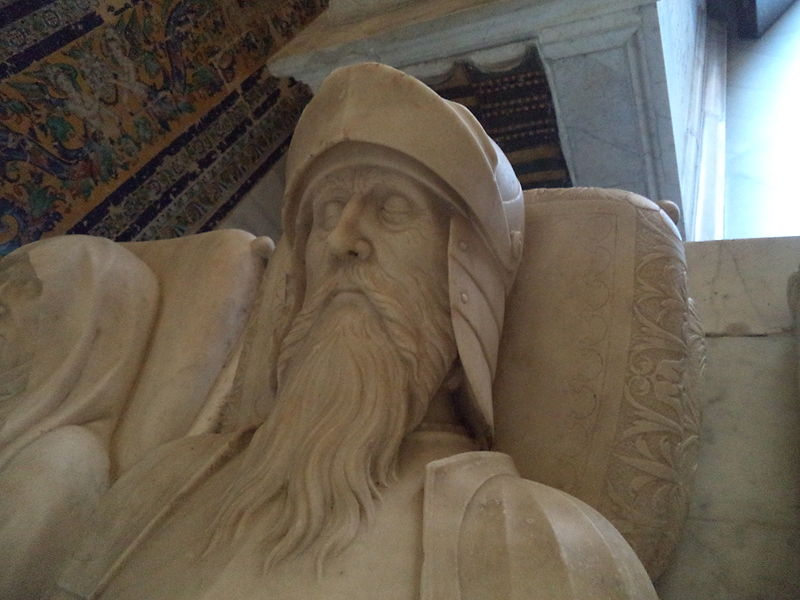
Per Afán de Ribera I Adelantado de Andalucía, Capita in his grave at the monastery of Santa Maria de las Cuevas 1430:
1445: Olmedo: Supporters of John II of Castile (under Baron Alvaro de Luna) defeat Rebel Nobility at Olmedo (Nicolle, 1988). 1447: 1447 Catalina de Ribera y
Hurtado de Mendoza, Born: Abt. 1447of Huelva, Spain Mother: María Hurtado de Mendoza de los Marqueses de Santillana, b. Abt. 1415, of Spain, d. Yes, date unknown Family: Pedro Enríquez de Quiñones, Señor de Tarifa y Alcalá de los Gazules, b. Abt. 1436, of València, Spain, d. Yes, date unknown
1449: Portuguese Civil War (Nicolle, 1988). 1450: 1457: Don Rodrigo de Ribera, a gentleman of Sevilla (Born1407). Pruna came under the protection of the Order of Calatrava until 1457, when on 17 October of that year Enrique IV gave the village to his vassal, Don Rodrigo de Ribera, a gentleman of Sevilla. It is believed from his writings that the King of Sevilla gave him Pruna because he feared the Order of Calatrava could not defend the border from the Moors. Don Rodrigo sorted out the Moors and the King allowed him to keep the land so long as he did not sell it, or otherwise dispose of to anyone other than the King. Don Rodrigo rebuilt the castle, repopulated the area, and put in place much of the present village of Pruna. The actual birth of modern Pruna is said to be the site of an old watch tower, at the side of the road from Ronda to Osuna, on the present day Calle Ronda. He sent the population from the old village of Pruna, inside the castle to this spot "Within range of a rifle shot of the castle and fortress of the village of Pruna". It is thought the move was made to escape the unhygienic, and epidemic ravaged confines of the castle, which was also excessively hot in the summer. Don Rodrigo gave the village the arms of the Ribera family, which helped defend it from attack. From Rodrigo the village passed to his son Don Pedro de Ribera. Unfortunately he could not hang on to it and it was sold to the Marques de Cadiz Don Rodrigo Ponce de Leon on 23 September 1482 for 4 million Maravedies. Subsequently ownership changed hands again, this time to the Duque de Arcos de la Frontera. 1458-1491: Portugal captured Moroccan Atlantic ports (Nicolle, 1988). 1460:
Emblematic allegorical woodcut (c. 1820) made during the Trienio Liberal. The political constitution illuminates the Aragonian shield that had been enclosed by the royal crown. The dynastic union in 1137 between Petronila, Queen of Aragón, and Ramon Berenguer IV, Count of Barcelona, produced a son, Alfonso II of Aragón who inherited all their respective territories creating the Crown of Aragón which included all lands and people, titles and states previously outside of the Kingdom of Aragón. The Crown of Aragón was effectively abolished after the dynastic union with Castile (1469) but the title continued to be used until 1714. The dynasty of the Kings of Aragón (called by some present-day historians "Kings of Aragón and Counts of Barcelona") ruled the present administrative region of Aragón, Catalonia, and later the Balearic Islands, València, Sicily, Naples and Sardinia (Aragonese Empire). The monarch was known as King of Aragón and also held the titles of King of València, King of Majorca (for a time), Count of Barcelona, Lord of Montpellier, and (temporarily) Duke of Athens and Neopatria. Each of these titles gave him sovereignty over the specific region, and the titles changed as territories were lost and won.1470s: Castilians conquered the Canaries (Nicolle, 1988). 1471: Juan de Silva y Ribera, I marqués de Montemayor 1471-1538 (66 years) Juan Luis de Silva y Ribera, IV
marqués de Montemayor Son: of Pedro de Silva y Ribera and
Teresa de Acuña y Guzmán Father: of Juan Francisco de Silva y Ribera, V marqués de Montemayor y I marqués del Aguila and Teresa de Silva y Mendoza Juan Francisco de Silva y Ribera, V
marqués de Montemayor y I marqués del Aguila 1472: Seville in the last quarter of the 15th Century. Pedro González de la Sal became a denizen of his adopted city and also served as jurado around the year. The names of two of his sons, Diego and Fernando, appear frequently in the Sevillian Protocols. Both were active participants in the trade with the New World, like most members of the family. A nephew of Pedro González de la Sal, Juan de la Sal, married Isabel Hurtado, and their children Ana and Diego married into the Alcázar family. Several members of the Sal served in the New World as agents for their relatives, including Diego, husband of Luisa del Alcázar, who in 1554 went to Tierra Firme as factor for his brother Lucas. Juan de la Sal followed the converso practice of intermarrying with families of similar background, such as the Hurtado and the Gutiérrez. Although the origin of the Hurtado was not questioned in the pruebas of 1627 (the Juan de Jáuregui inquiry), accusations against them came to light in a subsequent investigation in 1642 for Jáuregui's nephew Miguel de Jáuregui y Guzmán. On this occasion the mother of the poet Jáuregui was accused of being a descendant of a person who was burned in effigy by the Inquisition, and even though it was not clear who this individual was, there was some indication that he belonged to the wealthy merchant Hurtado family. Gómez Hurtado (brother of the Isabel married to Juan de la Sal) was one of the most successful Sevillian Converso merchants during the first half of the 16th Century. At his death he left a large fortune that was distributed among his nephews and nieces, one of whom was Lucas de la Sal, Jáuregui's maternal grandfather. The Gutiérrez are another case in point. Merchant Pedro Gutiérrez (husband of Beatriz de la Sal) and his brother Ruy Díaz de Segura, whose profession of trapero (old-clothes dealer) was traditional among the Conversos and their ancestors were among the richest Sevillian businessmen at mid-century. Ruy Díaz de Segura owned three ships engaged in the carrera de Indias: the caravel Santa María del Cabo, the Santa María de la Regla in association with his cousin Pedro de Medina, and the Santa María de la Consolación. In 1525, he was one of the three converso merchants who tried to purchase the farm of the almojarifazgo of Santo Domingo. His brother Pedro Gutiérrez served as his factor in Santo Domingo during the years 1524 to 1527. Upon his return to Seville he devoted himself to the Afro-American slave trade, often in association with Lucas de la Sal. Jerónima de León Y del Alcázar Returning again to the Alcázars, Jerónima de León, another sister of the poet Baltasar del Alcázar, also married into a suspect family. Her husband Pedro de Ribera was the son of Licentiate (Licentiate is the title of a person who holds an academic degree known as a licence or a licentiate. The term derives from Latin licentia, freedom (from Latin licere, to allow), which is applied in the phrases licentia docendi meaning permission to teach and licentia ad practicandum signifying someone who holds a certificate of competence to practice a profession.) Luis Sánchez de Ribera and María de Palma, natives of Cordova. Pedro appears in the Sevillian Protocols along with his brother Diego as an investor in the trade with the Indies. In 1546, he leased the property of Almuedana from the Countess of Gelves, mother of that same Count of Gelves who employed the poet Baltasar del Alcázar as his financial administrator.The union of Jerónima de León and Pedro de Ribera is just another example of intermarriage among the New Christian families (Conversos) and once again reveals the Converso origin of the Alcázars. Three generations of Alcázars were linked through marriage to a large group of families of similar background whose wealth was derived from trade. These families constituted the governing, mercantile, and intellectual elite of Seville during this period. 1474 Isabella I was Queen of Castile and León. This marked the opening of a period of growing success for Spain. 1474-1479: Castilian War of Succession - Civil war in Castile; Castilian-Aragonese under Isabella and Ferdinand eventually defeated the Castilian-Portuguese (Heath, 1982; Nicolle, 1988). 1474: In 1474, Catalina de Ribera y Hurtado de Mendoza (? - January 13, 1505), XVII Lady of the House of the Bank and IV Countess of Los Molares, Lady of el Coronil El Coronil is a city located in the province of Seville, Spain.
Las Aguzaderas The Castle of Las Aguzaderas is a fortress located in the municipality of El Coronil, about 3 km from the town center, built, according to some sources, by the Arabs. Its definitive Foundation dates from the 14th Century, having been modified in the 15th and 16th centuries.) Catalina married: Pedro Enríquez de Quiñones, IV greater Andalucía Adelantado (I Lord of rate (1493) and IV in advance most of Andalucía). They had two sons:
palace in Seville, Spain) from the family of the Pineda who sold it to pay a ransom for Juan Pineda, prisoner of the Moors in the Malaga Ajarquía. Although the contract was not in writing until 13 years later the residence ended up having a size and decoration similar to the Casa de Pilatos, coming to convertirese in the residence of the segundogenito. Catalina and Pedro Enríquez started the construction of the Casa de Pilatos at the end of the 15th Century. It became a beautiful Palace of 10,000 square metres, the second after the Reales Alcázares, richly decorated. Its ultimate completion would come at the hands of their son Fadrique who, according to tradition was due because to his pilgrimage to the Holy Land. Catalina had been widowed since 1492. She with his son Fadrique founded Hospital de las Cinco Llagas in 1500, after obtaining the Papal bull. The "bull" allowed the bearer create a charity hospital for the poor. It became unsafe. In 1540, it was moved its previous location in the Santiago Street and was then rebuilt at its final location in the north of the city of Seville. It was in operation until 1982 and then converted. The building has been for the seat of the Parliament of Andalucía since 1992.
1475: Portuguese (Alfonso V) besieged and took Toro about mid-year (Heath, 1982). Alfonso refuses to fight the Castilian relief army under Ferdinand of Aragón, and Ferdinands army disperses, however the Portuguese are kept cooped up in Toro by other supporters of Isabella. 1476: Toro - A Castilian army (Ferdinand of Aragón) besieges Portuguese held Zamora (Heath, 1982). Alfonso leads 8,500 Portuguese of the Toro garrison to Zamoras relief (Feb). The Portuguese, being well-equipped with artillery and Arquebusiers, bombard the Castilian positions for two weeks, before withdrawing toward Toro. Ferdinand pursues and catches the Portuguese at four to five miles from Toro as they negotiate a narrow pass beside the River Duero (March 1st). The Portuguese form up beyond the hills and allow the Castilians through the gap to face them. Most of Ferdinands infantry had been left behind in the pursuit, so he is slightly outnumbered. The Castilian right is disordered by the Portuguese Arquebusiers facing them and then routed by the Portuguese cavalry. However, reinforced by late arrivals, the routers rally at the pass and return to the battle. Toward evening, after three hours of fighting, the Portuguese begin to give, and they finally break when their flank is turned. 2,000 Portuguese are killed, although most of the army escapes in good order in the night. 1478: There was a truce established between Christians and Granadines, although raiding continued (Nicolle, 1998). 1478: About 5 km outside the city center along the road going to Malaga (the A381 roadway) is La Cartuja, a monastery whose real name is El Monasterio de Nuestra Señora de la Defension (The Monastery of Our Lady of Defense). This structure is considered the most important monument in the Province of Cadiz.
Per Afan de Ribera on the headstone tombstone of the Monastery of the Carthusian Order la Cartuja The monastery belongs to the Cartesian Order and no one can enter the monastery or church, but everyone can see the exterior and garden. The old Charterhouse or Cartuja is now occupied by the porcelain factory of Pickman & Co. The monastery was founded by Don Alvaro Obertos de Valeto in 1453. He was a noble of Jerez and the construction started in 1478. The basic plan of the monastery was Gothic, but since the construction took a long time, now it is a mixture of styles. The ancestor of the Ribera's family in Cáceres was Alfón de Ribera "el Doncel", son of the Adelantado of Andalucía, Don Perafrán de Ribera. In time of Banderías (disputes between nobility factions in 15th Century) he was governor of the castles of Azagala and Alburquerque, and he met death when he left Seville in 1443, and a group of supporters of Infantes de Aragón killed him. 1479: Spain gained control of the Canary Islands, important as a source of fish and sugar, but especially for their strategic location. Close to the West African coast, the islands would become valuable as a resupply base for Atlantic crossings. 1479: By 1479, Castile and Aragón were united when Ferdinand, the husband of Queen Isabella of Castile, became king of Aragón. Once united, these two powerful rulers extended their power. With unification the Catholic monarchs took control of Iberia. Once unified, the Spaniards had great victories in the southern part of the peninsula. 1480: 1481: The Granadines (Emir Abu Hasan) surprised the Castilian garrison of Zahara on a stormy night (December 26th) (Nicolle, 1998). The population was enslaved. 1482-1492: The Spanish from Castile-Aragón conquered the Kingdom of Granada (Nicolle, 1988). 1482: Spanish forces (2,500 cavalry and 3,000 infantry under Rodrigo Ponce de León, the Marquis of Cádiz) gathered at Marchena (February 25th) and marched to Antequera, crossed the Sierra Alzerifa, and then seized Granadine Alhama on a stormy night before dawn (February 28th) (Nicolle, 1998). Abu Hasan attempted to retake Alhama by siege (March 5th-19th) but withdrew unsuccessfully back to Granada. Muslim troops from Ronda raided the Arcos area in an attempt to tempt the Marquiz out of Alhama. In support of his men at Alhama, King Ferdinand marched to Lucena, sending reinforcements in Alhama (April 30th), withdrew back to Córdoba to organize a major force, and then formally took over Alhama (May 14th). Siege of Loja (Nicolle, 1998) King Ferdinand of Aragón attacked the Granadine City of Loja (July 1st). The city was defended by the octogenarian father-in-law of Muhammad XII, Ibrahim Ali al-Attar. Ferdinand returned to Córdoba. Abu Hasan marched on Loja and swept the Rio Frio (Mid-July). 1483: Battle of Axarquia (Heath, 1982; Nicolle, 1998). A fast moving Castilian force of 3,000 cavalry and 2,000 infantry (Master of Santiago Alonso de Cardenas, Marquis of Cádiz, Don Pedro Henriquez) raided the mountainous sierra of Axarquia. Their plan is to march through the Axarquia mountains and march back via the coast. Granadine horsemen from Malaga (Abd-Allah al-Zagal the future Muhammad XIII) ambushed the Castilian rearguard (Master of Santiago) when the vanguard and main body dispersed to plunder (March 19th). Elements of the Castilian main body (Marquis of Cádiz) rescued the rearguard, but none-the-less the Castilians decided to retreat to safety. For the rest of the day, and throughout the night, the Castilians floundered looking for a route through the mountains, all the while being attacked by Moorish handgunners and crossbowmen, and by avalanches of stones. The Marquis of Cádiz and 70 lances escaped to safety during the night. The remnants tried to break out the next day and most of the commanders escaped, but 800 men were killed and 1,600 captured. King Ferdinand ravaged the area around Illora (April 8th) and Tajar (April 14th), and resupplied the Alhama garrison (April 16th) (Nicolle, 1998). At the battle of Lucena (Heath, 1982; Nicolle, 1998) about 10,000 Granadines (Muhammad XII Abu Abd Allah) including 1,200-1,500 horse besiege Lucena. A small relief force of about 1,500 (Count of Cabra) marched from Baena across the sierras and surprised the Granadine camp (April 20th). The Granadine foot fled when the Lucena garrison attacked them from the other side. The Granadine horse put up a strong fight, but started to give ground slowly when the hero of the army, Ali Atar (Muhammads father-in-law), was killed. The Granadine Horse was disordered when they reached the rain-swollen river Xenil where their own foot were crowded trying to cross. 5,000 Granadines were killed or captured; Ibrahim Ali al-Attar, Muhammads father-in-law, was one of the slain. Muhammad became the first King of Granada to be captured by the Christians (April 21st). A large force from Malaga and Ronda (Al-Zagal) raided in the area of Ubera in early September (Nicolle, 1998), the infantry were left to hold the pass homeward and a cavalry ambush was stationed on the Lopera River. The remaining cavalry headed for Ubera but were driven off by a Christian force. The Christians went on to attack the Moorish infantry, and were in turn ambushed, but managed to defeat both Muslim threats (September 17th). The Christians went on to take Zahara (October). 1482 Don Juan de Ribera, lord of Montemayor Taken in 1486 The reason for the siege of Loja [ Loja is situated on the western side of the province of Granada, in Andalucía. Bordering to the north Iznajar (Province of Córdoba), Zagra, Algarinejo and Montefrio; to the south Alfarnate (Province of Malaga), Zafarraya and Alhama; to the east with Huétor-Tájar, Villanueva Mesía and Salar and to the west with Villanueva del Trabuco, Archidona, Villanueva de Algaida y Villanueva de Tapia (Province of Malaga) considered the door to the kingdom of Granada, due to its position between two mountain ranges, which appear as strong bastions] was due to its strategic value.When King Ferdinand lifted the siege of Loja in the retreat, Don Juan de Ribera twice saved the king
Statue of Ferdinand II of Aragón, the Catholic (14521516), at the Sabatini Gardens in Madrid, Spain King Ferdinand now perceived the wisdom of the opinion of the Marques of Cadiz, and that his force was quite insufficient for the enterprise. To continue his camp in its present unfortunate position would cost him the lives of his bravest cavaliers, if not a total defeat, in case of reinforcements to the enemy. He called a council of war late in the evening of Saturday, and it was determined to withdraw the army early the next morning to Rio Frio, a short distance from the city, and there wait for additional troops from Córdoba. The next morning early the cavaliers on the height of Albohacen began to strike their tents. No sooner did Ali Atar behold this than he sallied forth to attack them. Many of the Christian troops, who had not heard of the intention to change the camp, seeing the tents struck and the Moors sallying forth, supposed that the enemy had been reinforced in the night, and that the army was on point of retreating. Without stopping to ascertain the truth, or to receive orders, they fled in dismay, spreading confusion through the camp; nor did they halt until they had reached the Rock of the Lovers, about seven leagues from Loja. The King and his commanders saw the imminent peril of the moment and made face to the Moors, each commander guarding his quarter and repelling all assaults, while the tents were struck and the artillery and ammunition conveyed away. The King, with a handful of cavaliers, galloped to a rising ground, exposed to the fire of the enemy, calling upon the flying troops and endeavoring in vain to rally them. Setting upon the Moors, he and his cavaliers charged them so vigorously, that they put a squadron to flight, slaying many with their swords and lances, and driving others into the river, where they drowned. The Moors, however, were soon reinforced, and returned in great numbers. The King was in danger of being surrounded, and twice owed his safety to the valor of Don Juan de Ribera, lord of Montemayor.
The Marques continued, throughout the day to expose himself to the repeated assaults of the enemy; he was ever found in the place of the greatest danger, and through his bravery a great part of the army and camp was preserved from destruction. It was a perilous day for the commanders; for in a retreat of the kind, it is the noblest cavaliers who must expose themselves to save their people. The Duke of Medina Caeli was struck to the ground, but rescued by his troops. The Count of Tendilla, whose tents were nearest to the city, received several wounds, and various other cavaliers of the most distinguished note were exposed to fearful jeopardy. The whole day was passed in bloody skirmishes, in which the hidalgos and cavaliers of the royal household distinguished themselves by their bravery; at length, the encampments being all broken up, and most of the artillery and baggage removed, the bloody height of Albohacen was abandoned, and the neighborhood of Loja evacuated. Several tents, a quantity of provisions, and a few pieces of artillery, were left upon the spot, from the want of horses and mules to carry them off. Ali Atar hung upon the rear of the retiring army, and harassed it until it reached Rio Frio. Ferdinand returned thence to Córdoba, deeply mortified though greatly benefited by the severe lesson he had received, which served to render him more cautious in his campaigns and more diffident of fortune. 1484: The Spanish army (King Ferdinand) assembled at Antequera (Spring), marched to Alora, raided Coin, Cazabonela, Almjia, Cartama, Pupiana, Alhendrin and the Vega of Malaga before returning to Antequera (Nicolle, 1998). 1484: Spanish captured Alora (June 20th) (Nicolle, 1998). 1484: Spanish raided into Vega of Granada (September) (Nicolle, 1998). Some Spanish remained to support Muhammad XII of Granada. 1484: Spanish troops captured Senetil (September 20th) (Nicolle, 1998). 1484: Doña Catalina de Ribera bought El
Palacio de las Dueñas in 1484.
It has a typical Andalusian courtyard like that of the Pilate House which dominates the outdoor area, showing the majestic beauty of a whole. Behind, the garden leads to a beautiful courtyard surrounded by arches with columns of white marble, adorned with pillars holding platerescos [It is a modification of Gothic spatial concepts and an eclectic blend of Mudéjar, Flamboyant Gothic and Lombard decorative components, and Renaissance elements of Tuscan origin. Examples of this syncretism are the inclusion of shields and pinnacles on facades, columns built in the Renaissance neoclassical manner, and facades divided into three parts (in Renaissance architecture they are divided into two).]. On top of this gallery with arches is built another Mudejar style. The palace has at the bottom to one side of the gallery, a chapel, with a high altar adorned with ceramic tiles (Typical of Seville). Upstairs is a luxurious salon with a gold octagonal roof and paneled ceiling. One of its main attractions is the large and decorative art collection amounting to 1,425 pieces. According to an inventory of the Junta de Andalucía, it includes works of art, furniture and other antiques. The collection is important to the whole of Spanish art. From the 19th and 20th centuries Maríano Benlliure, Federico de Madrazo, Sorolla, Zuloaga, Gonzalo Bilbao, Carmen Laffón). There are also some previous pieces Dueñas: Jacopo Bassano ( The Crockery ), Sofonisba Anguissola , Annibale Carracci , Francesco Furini ( The Creation of Eve ), Luca Giordano , Giovanni Paolo Pannini , José de Ribera ( Christ crowned with thorns ), Francisco Antolínez , Joaquín Inza and a Virgin of Neri di Bicci (who chairs the altar of the chapel). These are but a portion of the huge gallery belonging to this family, whose main jewels are kept in Madrid in the Palacio de Liria. Dueñas likewise accumulated abundant antique furniture, ceramics, tapestries, and many more decorative objects. The collection also includes a drawing and watercolor by Jackie Kennedy completed during one of her stays in the 1960′s. The art collection is subject to the laws of Andalucía which prohibits their sale and ensures their being kept together in the palace. 1485: Al-Zagal drove Muhammad XII from Almeria in February) (Nicolle, 1998). He then fled to Ferdinand at Córdoba. Ferdinand besieged Coin and Cartama. Al-Zagal then attempted to relieve the sieges (April), but first Coin fell (April 27th) then Cartama (April 28th). The garrison of Ronda raided Medina Sidonia but returned to find its city besieged by King Ferdinand (Early-May). After Abu Hasan of Granada died Al-Zagal assumed the title of Emir (Late-May) and then defeated a Christian foraging party from Alhama on his way to Granada. In late August, three groups of Spanish march toward Moclin. Al-Zagal ambushed and defeated the first group, although it was rescued by the second group of Spanish in early September. After Al-Zagal entered Moclin, the third Spanish group (Ferdinand) joined with the other two and they took the castles of Cmbil and Albahar around September 23rd. The Spanish of Alhama also took the castle of Zalea, in September. 1485: The Town of Torre Alháquime was passed over to the dominion of the Ribera family in the beginning of the 15th Century. Its origins come from the Muslim occupation. In 1327, it was occupied by Christian troops but once again fell under Muslim rule in 1333. This lasted until the beginning of the 15th Century, when it was passed over to the dominion of the Ribera family. It was definitively conquered in 1485 by the Marquis of Cádiz. Later, it was to pass once again to the feudal estate of the Ribera family, to the duchy of Alcalá de los Gazules and finally to the House of Medinaceli.
1487: Nicolás de Ribera When Olvera fell to the conquering army of Alfonso XI in 1327, it came under the control of the Gúzman family, who were awarded control of much of the region for their role in the defence of Tarifa during the Reconquest. It later passed into the hands of the dukes of Osuna. Its most famous son is probably Nicolás de Ribera, born there in 1487, and one of the leaders of Spain's conquest of Peru. He was made mayor of its capital, Lima, in 1535.
The Church of Nuestra Señora de la Encarnación and the castle
Settled as a town by the Phoenician and Roman periods, the latter called it either Hippa or Hippo Nova. Its first appearance in history is in the 1st Century in the History of Pliny. Like much of the Iberian Peninsula, the area was overrun by Visigoths from the Baltic region in the 5th Century and they were later expelled by Berber armies from North Africa in the 9th Century. The Berbers, roughly termed as "Moors" in most histories of Spain, began construction of the town, which they called Wubira, or possibly Uriwila, as a defensive garrison that they managed to hold on to under the rule of Granada's Nasrid rulers until the town fell to the Christian reconquistadores in 1327. The origin of the town's name is unknown. As was often the case, Roman, Visigoth and Moorish names fused into the later Spanish word, and Olvera has been variously described as a neologism for a well, woodland or olive grove. Olive oil is one of the area's main agricultural products. When Olvera fell to the conquering army of Alfonso XI in 1327, it came under the control of the Gúzman family, who were awarded control of much of the region for their role in the defence of Tarifa during the Reconquest. It later passed into the hands of the dukes of Osuna. Its most famous son is probably Nicolás de Ribera, born here in 1487, and one of the leaders of Spain's conquest of Peru. He was made mayor of its capital, Lima, in 1535. 1488: A sea route to the Far East was found when, in 1488, the Portuguese navigator Bartolomeu Dias sailed around the Cape of Good Hope, at the southern tip of Africa. Also, it was considered necessary to protect Spains shipping activities and establish fortified positions for defense against Muslim raids. Those areas could also serve as outposts for export of African slaves and precious metals. 1490:
Commentary When one views pre-Spains (Before 1492) Iberian history, he or she is struck by the complexity of Iberias long and difficult settlement. The various tribes of original inhabitants were generally of homogenous European stock. By this I mean to say, before they developed into distinct ethnic groups. As these inhabitants of the Iberian Peninsula (modern Spain and Portugal) settled the land in different regions of the Peninsula each group expanded, took on its own character, and developed its own world view. In short, these tribes were separate and apart. They would only later become Iberians. About 500-250 B.C., the Celts intermixed with these original Iberians during the Celtic migration. The Celts were descendents of original inhabitants of Central Europe which developed the Celt language, Celt culture, and spread it throughout Europe. In the end, they formed the majority of the genetic composition of the modern day Spanish people. These later became the Celtiberians or Celts of Iberia. The Greeks and Phoenicians (Carthaginians) settled their various colonies along the Mediterranean coast in those ancient times. They came as traders and explorers. While they had a very minor genetic contribution in the south of the Peninsula, one can accept that they had a tremendous cultural and historical impact upon what would become Spain. What is now roughly modern Spain and Portugal came under Roman conquest. Roman Hispania began mainly due to the actions of Carthages expansion. At the end of the First Punic War (264-241 BCE) Rome defeated Carthage and claimed Sicily, Sardinia, and Corsica. This placed an increased emphasis on the consolidation of territories, power, and control of Roman Hispania. Later after consolidation of its gains, the Romans would expand their grip on the Peninsula. Rome's expansion of Hispania however would not go uncontested. After the war Rome divided Spain into two provinces, known as Hispania Citerior (Near) and Hispania Ulterior (Far). During the second Punic war the native tribes of the region eventually turned against the Romans in a series of revolts. That is not to say that the original tribes and the people of Hispania didnt have a great deal of positive influence from Phoenician (Carthaginian), Greek, and Roman settlements. The fact is that each brought to the Peninsula advancements in technology, agriculture, and new ideas. At issue was the tendency of these Iberian tribes to want to maintain their own identities and freedoms. There was also ongoing inter-tribal warfare. In Roman times the Celtiberians were composed of the Arevaci, Belli, Titti, and Lusones. The Arevaci dominated the neighboring Celtiberian tribes from the powerful strongholds at Okilis (Modern Medinaceli) and Numantia. The Belli and the Titti were settled in the Jalon valley, the Sierra del Solorio separating them from the Lusones to the northeast. The Lusitani lived in what is now Portugal. They were a group of warlike tribes who, despite defeats, resisted Roman domination until their great leader, Viriatus, was killed (139 B.C.). In the 1st Century B.C. they joined in supporting Sertorius, against the government in Rome. During and throughout the Imperial Period, Hispania was significantly "Romanized". The area came to be one of the most important territories of the Roman Empire. Later, the emperors Trajan and Hadrian were both born in Hispania. Hispanias importance was so great that all of the people of Hispania were granted the status of Roman citizen. Given the long period of Roman dominance, they left their genetic imprint on the regions they settled. As Rome controlled the Iberian Peninsula for some 600 years, it left a strong legal, linguistic, and architectural legacy. It also planted a cultural phenomenon which outlasted its laws and language. This was Christianity. Christianity was not a Roman product, but an insurgency into Roman life. Christianity abandoned Greek for Latin, as its preferred language. Later, Rome became the headquarters of the Church. Eventually, the Spanish-born emperor Theodosius declared Christianity the religion of the Empire in 380. Roman Latin existed before Christianity. As fate would have it, Christianity made its way throughout Europe via the Latin language. This would last until it was eventually replaced when Roman linguistic and political uniformity eroded. Latin continues to remain the official language of Catholic Church and its Vatican. Rome is still the center of Roman Catholicism. Roman Catholicism remained entrenched in the European mind and later formed the basis of the Holy Roman Empire. That formation which is generally attributed to the French king, Charlemagne who was crowned emperor in Rome in 800, was truly a product of the Church. During the High Middle Ages (1001A.D.-1300A.D.), the battle of the whole of Christendom became one with the fight against the African Moors on the Iberian Peninsula. Many believe that the Reconquista was originally a war of Christian conquest over African Muslim Islam. Later, it appears, it underwent significant change in emphasis toward a religiously justified war of liberation. The papacy justified and encouraged Christian knights to war with the Moorish "infidels". So it was that Christianity remained one of the great influences for the Founding of Spain.The Jews established communities throughout Spain and Portugal in the early centuries B.C., during the Roman period, and became known as Sephardic Jews. The Golden age of Jewish culture in Spain started with the Umayyad conquest of Iberia in 711 and lasted until the end of the Caliphate of Cordoba and the Almoravid invasion in the 11th century. By the 14th century, approximately 8% of the Spanish population was Jewish. The Germanic invasions of the 5th Century brought Germanic peoples (Visigoths in particular) who conquered almost the entire Peninsula and became the ruling class. They gradually intermixed with the local Celtiberian population, providing a minor contribution to the Iberian genetic composition. That is not surprising considering that the largest contingent was Suebi and only 40,000 of which settled permanently in Iberia. Today, Galicia, northern and central Portugal, and Catalonia are the regions with the highest ratios of Germanic Y-DNA (Approx. 5 to 10% of the male lineages). These areas represent the historical settlements of the Suebi and the Frankish in Catalonia's case. A reasonable estimation is that Germanic genes represent no more than 1% of the Iberian gene pool, with maximums of perhaps 3% or 4% in Galicia and northern Portugal. In the 7th century, early Muslims from the Arabian Peninsula began spreading their new faith. They conquered a good part of the Middle East and the whole of North Africa under the Umayyad Caliphate. In 711, they crossed the Strait of Gibraltar and invaded Iberia, which they called Al-Andalus. This began the African Moorish period on the Iberian Peninsula, which would last for nearly eight centuries. It ended with the fall of the Emirate of Granada to the Catholic monarchs in 1492. As in the case with the Jewish population, many Muslims converted to Christianity (Called Moriscos) and remained in Spain and Portugal. Possibly 275,000 Morisco converts were expelled from Castille and Valencia in the early 17th Century. However, many lingered in other regions, notably Aragon, Andalusia, Extremadura and Portugal. At one point, Moriscos accounted for 20% of the population of Aragon. It is no coincidence that their haplogroups make up 20% of modern Aragonese male lineages, despite the fact that the region was never under Phoenician or Greek influence. To be sure, through the process of e thnogenesis these tribes became what is modern day Spain. Ethnogenesis (A "group of people, nation", and genesis "beginning, coming into being"), came to the Iberian Peninsula slowly. Each of these tribes had first to go through the process by which as a group of people, a tribe, each acquired a tribal ethnicity. As each tribe explored and settled its region, over time, each developed its own group identity. They were then identified by other tribes as distinct ethnic groups. For each tribe the process originated both through the process of self-identification as well as, coming about as the result of outside identification from other tribes. Undoubtedly, ongoing warfare and survival caused stronger internal identification as a group encouraging a sense of ethnicity.Later, this ethnogenesis was expanded via self-identification through religion. With Iberian roots in Christianity, it soon began to transition from many views of Christian expression, coalescing into one. Eventually, it united under Roman Catholicism, so as to form one mass, one community of religion. With one religion as an underpinning, ethnogenesis expanded toward self-identification as a Christian Iberians.African Muslim conquest of Iberia brought with it the tyranny of an external religion, Islam. It was this process which would lend itself to the expedited ethnogenesis of the entire Iberian Peninsula as one nation, Spain. The exception however, would be Portugal.Upon the decline and fall of the Roman Empire and during the Germanic invasions of the Iberian Peninsula, Portugal, along the western coast, slowly developed an identity and culture all its own. It was unique to the remainder of the peninsula. It had not shared the identity and culture of the Roman years as the rest of Iberia had. During the Medieval Period, the Spanish kingdoms of Iberia became politically intertwined with the Catholic Church and its popes. Many speculate that this was due to African Muslim domination of Iberia, necessitating closer ties to the Catholic Church for survival. Later, Catholic adherence and closeness to Rome became even more of a necessity during the Age of Exploration (Beginning in the 15th Century). Spain was to have an important role in the expansion and innovation of European naval technology and use. Spanish access to the Atlantic made sea travel and exploration possible, as did its rapidly developing naval tradition. In the end, the Church and its Catholic popes assisted Spain and Portugal by defining and supporting an organized, structured Spanish Vs Portuguese monopolization of the New World, particularly Central and South America. 02/24/2015 07:19 PM
|



 The
next to arrive were the Phoenicians. They came from the Eastern Shore of
the Mediterranean Sea, modern day Lebanon. Their land was arid and
inhospitable for farming. So they turned to the sea for food and
eventually commerce. They became the greatest travelers and traders of
their time. The Phoenicians invented the alphabet and taught several
cultures their advanced system of writing.
The
next to arrive were the Phoenicians. They came from the Eastern Shore of
the Mediterranean Sea, modern day Lebanon. Their land was arid and
inhospitable for farming. So they turned to the sea for food and
eventually commerce. They became the greatest travelers and traders of
their time. The Phoenicians invented the alphabet and taught several
cultures their advanced system of writing. Then
the Greek settlers came to what they called Hesperia (to the west),
later Spain. They founded several towns including Rosas, Ampurias and
Sagunto. Ancient Greece was one of the largest contributors to
present-day civilization. Democracy, philosophy, astrology, biology,
mathematics, physics, and theatres are only a few of its contributions
to us.
Then
the Greek settlers came to what they called Hesperia (to the west),
later Spain. They founded several towns including Rosas, Ampurias and
Sagunto. Ancient Greece was one of the largest contributors to
present-day civilization. Democracy, philosophy, astrology, biology,
mathematics, physics, and theatres are only a few of its contributions
to us.  Magnificent
Greek cities have withstood the onslaught of natures power for
thousands of years. They still stand today for us to view with great
wonderment.
Magnificent
Greek cities have withstood the onslaught of natures power for
thousands of years. They still stand today for us to view with great
wonderment.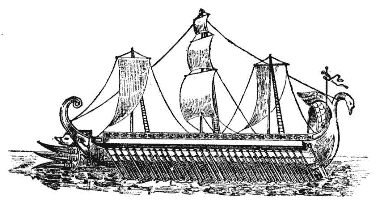 The
location of Saguntum is on the Mediterranean coast of Spain, at the
southern end of the Balearic Sea, near a peaceful bay. An early Iberian
settlement, it lays inland a mile or so supplying farming villages
access to the sea. Since there is no river close to it water must be
diverted into a channel and led near the city. The city proper was built
on a ridge looking down upon a peaceful cove. Today, it is one of the
best sand beaches available in Spain. Situated on a plateau, about
thirty feet above the beach, the fortress is high on the ridge.
The
location of Saguntum is on the Mediterranean coast of Spain, at the
southern end of the Balearic Sea, near a peaceful bay. An early Iberian
settlement, it lays inland a mile or so supplying farming villages
access to the sea. Since there is no river close to it water must be
diverted into a channel and led near the city. The city proper was built
on a ridge looking down upon a peaceful cove. Today, it is one of the
best sand beaches available in Spain. Situated on a plateau, about
thirty feet above the beach, the fortress is high on the ridge.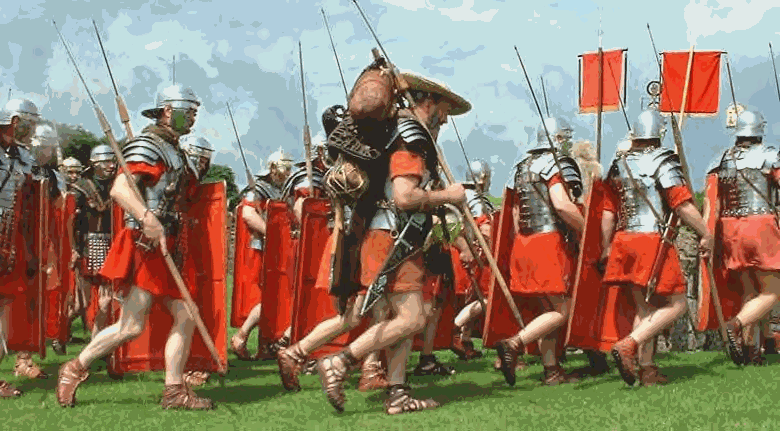
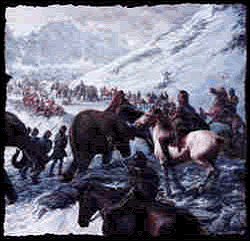

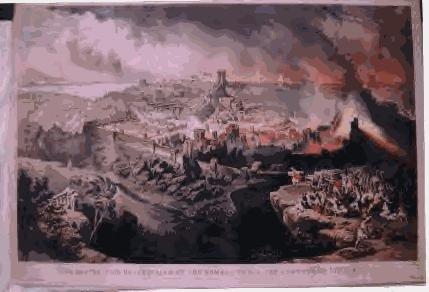 A
third and more probable explanation is to assume that the enlargement of
the first Jewish settlements in the Iberian Peninsula took place after
Jerusalem was destroyed by the Romans in 70 A.D. This could have been
mistaken as their first introduction into Iberia. The war against Rome
and the complete destruction of the Temple opened up the great Jewish
Diaspora (dispersion) throughout the Mediterranean. The Diaspora could
have easily reached Roman Hispania (Spain) in the 1st Century. Jewish
migration to Iberia appears to have been successive in nature, gradually
introducing Jewish culture and religion to the area.
A
third and more probable explanation is to assume that the enlargement of
the first Jewish settlements in the Iberian Peninsula took place after
Jerusalem was destroyed by the Romans in 70 A.D. This could have been
mistaken as their first introduction into Iberia. The war against Rome
and the complete destruction of the Temple opened up the great Jewish
Diaspora (dispersion) throughout the Mediterranean. The Diaspora could
have easily reached Roman Hispania (Spain) in the 1st Century. Jewish
migration to Iberia appears to have been successive in nature, gradually
introducing Jewish culture and religion to the area.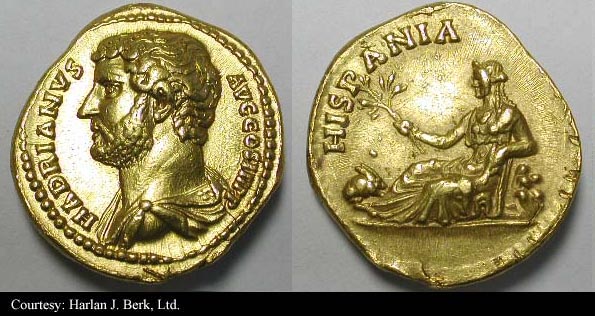 Although
the first date of Jewish settlement in Spain is unknown, it is believed
that Jews lived on the Iberian Peninsula as early as Roman times.
Between 100 A.D. and 300 A.D., large Jewish populations had settled in
towns in southeastern Spain, and the region south of Córdoba became a
region of major Jewish settlement. Jews lived as farmers and landowners
under the Visigoths, but they also suffered various persecutions.
Although
the first date of Jewish settlement in Spain is unknown, it is believed
that Jews lived on the Iberian Peninsula as early as Roman times.
Between 100 A.D. and 300 A.D., large Jewish populations had settled in
towns in southeastern Spain, and the region south of Córdoba became a
region of major Jewish settlement. Jews lived as farmers and landowners
under the Visigoths, but they also suffered various persecutions.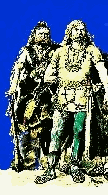 By
the 5th Century A.D., the Germanic Visigoths were already a romanized
people who considered themselves the heirs of a defunct imperial Roman
power. Attacked relentlessly, around the middle of this century,
pressures forced the Visigoths to establish their capital in Toledo at
the center of the Iberian Peninsula. The Suevi from the west (Galicia),
the Cantabrian-Pyrenaic herdsmen from the north, the Byzantines from the
south, and the Betica continued to war with the Visigoths.
By
the 5th Century A.D., the Germanic Visigoths were already a romanized
people who considered themselves the heirs of a defunct imperial Roman
power. Attacked relentlessly, around the middle of this century,
pressures forced the Visigoths to establish their capital in Toledo at
the center of the Iberian Peninsula. The Suevi from the west (Galicia),
the Cantabrian-Pyrenaic herdsmen from the north, the Byzantines from the
south, and the Betica continued to war with the Visigoths.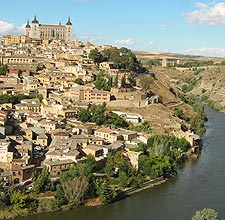
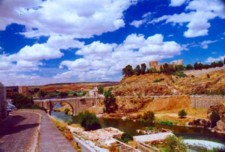 T
T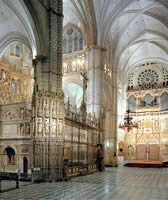 Throughout
the 15th and early 16th Century Spanish monarchs continued to lavish
money on the city: Ferdinand and Isabella built the monastery of San
Juan, and Emperor Charles V rebuilt the alcazar. In 1561 A.D., the
city's fortunes were overshadowed by the creation of Madrid, some 70 km
north, as the nation's capital. Toledo was left as the seat of the
primacy of Spain, as it remains today.
Throughout
the 15th and early 16th Century Spanish monarchs continued to lavish
money on the city: Ferdinand and Isabella built the monastery of San
Juan, and Emperor Charles V rebuilt the alcazar. In 1561 A.D., the
city's fortunes were overshadowed by the creation of Madrid, some 70 km
north, as the nation's capital. Toledo was left as the seat of the
primacy of Spain, as it remains today.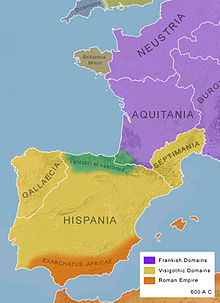
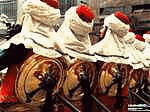 Many
historical events shaped the psyche of the Spanish people, but
none more than the invasion of Iberia (Spain) by the African
Moors who had crossed
Many
historical events shaped the psyche of the Spanish people, but
none more than the invasion of Iberia (Spain) by the African
Moors who had crossed 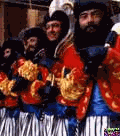 To
clarify, the Berbers are Aboriginal Caucasoid peoples of
Northern Africa. They inhabit the lands lying between the Sahara
and the Mediterranean Sea and between Egypt and the Atlantic
Ocean. Berbers today form a substantial part of the populations
of Libya, Algeria, and Morocco. Except for the nomadic Tuareg,
the Berbers are small farmers, living under a loose tribal
organization in independent villages. They have developed local
industries (iron, copper, lead, pottery, weaving, and
embroidery).
To
clarify, the Berbers are Aboriginal Caucasoid peoples of
Northern Africa. They inhabit the lands lying between the Sahara
and the Mediterranean Sea and between Egypt and the Atlantic
Ocean. Berbers today form a substantial part of the populations
of Libya, Algeria, and Morocco. Except for the nomadic Tuareg,
the Berbers are small farmers, living under a loose tribal
organization in independent villages. They have developed local
industries (iron, copper, lead, pottery, weaving, and
embroidery).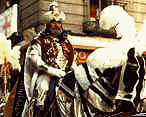 The
origin of the Berbers is uncertain. Many theories have been
advanced relating them to the Canaanites, the Phoenicians, the
Celts, the Basques, and Caucasians. In classical times the
Berbers formed such states as Mauretania and Numidia.
The
origin of the Berbers is uncertain. Many theories have been
advanced relating them to the Canaanites, the Phoenicians, the
Celts, the Basques, and Caucasians. In classical times the
Berbers formed such states as Mauretania and Numidia. Now
stronger, the wars of reconquest by the Northern Christian
Kingdoms would not be halted. While the rest of Europe fervently
marched on Papal crusades and fought to regain the Holy Land,
the Spaniards fought a religious crusade against Moorish
infidels. The Spanish would know no rest until the wars for
their land and faith were won. This sacred duty left an
indelible mark on the Spanish soul. No man of breeding regarded
himself as other than a soldier for the Christian Northern
kingdoms against the unholy Moors. They became conquistadors
dedicated to the destruction and expulsion of the hated African
Moors and their "Moon-God", Allah, from Iberian soil.
Over time, the Moorish strongholds in Spain surrendered to the
Christian kingdoms.
Now
stronger, the wars of reconquest by the Northern Christian
Kingdoms would not be halted. While the rest of Europe fervently
marched on Papal crusades and fought to regain the Holy Land,
the Spaniards fought a religious crusade against Moorish
infidels. The Spanish would know no rest until the wars for
their land and faith were won. This sacred duty left an
indelible mark on the Spanish soul. No man of breeding regarded
himself as other than a soldier for the Christian Northern
kingdoms against the unholy Moors. They became conquistadors
dedicated to the destruction and expulsion of the hated African
Moors and their "Moon-God", Allah, from Iberian soil.
Over time, the Moorish strongholds in Spain surrendered to the
Christian kingdoms. 
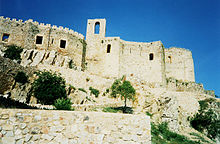
 One
cannot speak of Spain and its fabled knights without touching
upon its greatest knight, "El Cid (1043-1099) Rodrigo
Diáz de Vivar".
One
cannot speak of Spain and its fabled knights without touching
upon its greatest knight, "El Cid (1043-1099) Rodrigo
Diáz de Vivar".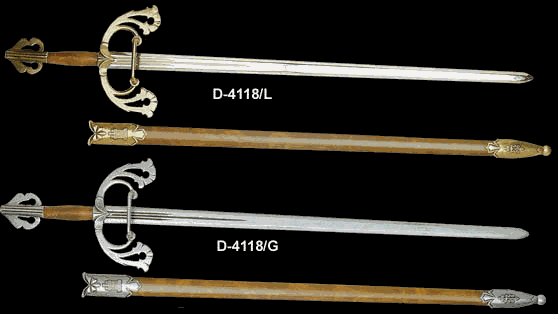 After
King Sancho was assassinated in 1072, the Castilians
proclaimed Alfonso to be their king. El Cid accused Alfonso of
taking part in the murder of his brother, Sancho.
After
King Sancho was assassinated in 1072, the Castilians
proclaimed Alfonso to be their king. El Cid accused Alfonso of
taking part in the murder of his brother, Sancho. His
first decade of exile was spent fighting for the causes of various
Christian and Moslem rulers. Accepting challenge after challenge,
his fame as a great warrior grew. The decorative
wall hanging to the left is designed after a shield used by
Spanish hero, El Cid, during his 11th Century exploits. Crafted
from 20-gauge steel, this shield has a burnished metal finish and
solid brass trim and fittings. The piece is 24 3/4 inches by 18
1/4 inches.
His
first decade of exile was spent fighting for the causes of various
Christian and Moslem rulers. Accepting challenge after challenge,
his fame as a great warrior grew. The decorative
wall hanging to the left is designed after a shield used by
Spanish hero, El Cid, during his 11th Century exploits. Crafted
from 20-gauge steel, this shield has a burnished metal finish and
solid brass trim and fittings. The piece is 24 3/4 inches by 18
1/4 inches. By
1090, the Cid, with both the kings of Saragossa and Aragón,
resisted the advance of the Berber Almoravids in eastern Spain.
Two years later, during November of 1092, he began a siege of
València. By 1094, El Cid had conquered the region of València
offering the region to King Alfonso. Alfonso accepted his offer
and El Cid was made Lord of València. There the Cid maintained a
Christian presence in the largely Moslem town, ruling until his
death on July 10, 1099. His widow Jimena continued to rule, but in
1102, she was forced to abandon València to the advancing
Almoravids.
By
1090, the Cid, with both the kings of Saragossa and Aragón,
resisted the advance of the Berber Almoravids in eastern Spain.
Two years later, during November of 1092, he began a siege of
València. By 1094, El Cid had conquered the region of València
offering the region to King Alfonso. Alfonso accepted his offer
and El Cid was made Lord of València. There the Cid maintained a
Christian presence in the largely Moslem town, ruling until his
death on July 10, 1099. His widow Jimena continued to rule, but in
1102, she was forced to abandon València to the advancing
Almoravids.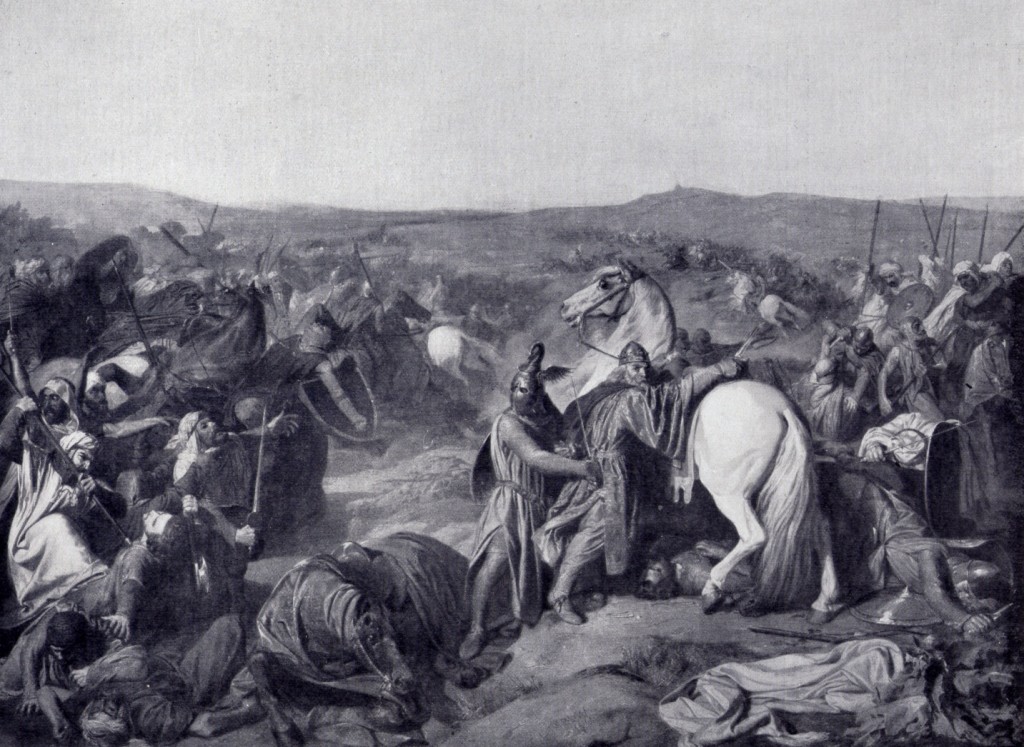
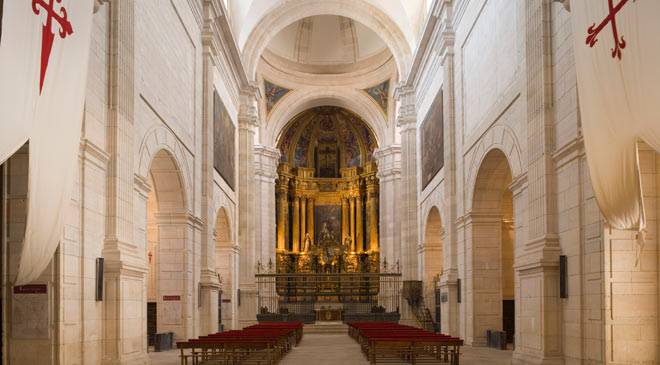 The
Escorial of La Mancha Monastery was chosen in 1174 to house the
headquarters of the Saint-Jacques order. This fortified monastery
has a shape that reminds one of the Escorial Mountains. Pedro
de Ribera later built the south façade, Baroque style of the
Escorial of La Mancha Monastery
The
Escorial of La Mancha Monastery was chosen in 1174 to house the
headquarters of the Saint-Jacques order. This fortified monastery
has a shape that reminds one of the Escorial Mountains. Pedro
de Ribera later built the south façade, Baroque style of the
Escorial of La Mancha Monastery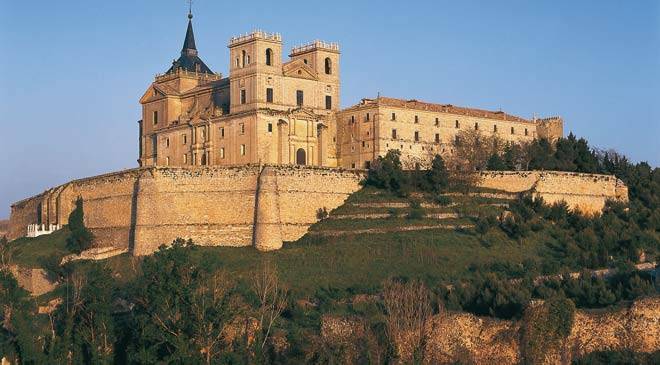

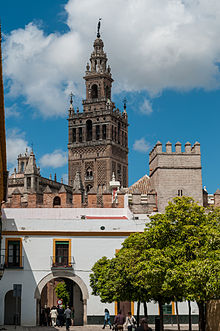 The
20th Century in Seville saw the horrors of the Spanish Civil War,
decisive cultural milestones such as the Ibero-American Exposition
of 1929 and Expo'92, and the city's election as the capital of the
Autonomous Community of Andalucía.
The
20th Century in Seville saw the horrors of the Spanish Civil War,
decisive cultural milestones such as the Ibero-American Exposition
of 1929 and Expo'92, and the city's election as the capital of the
Autonomous Community of Andalucía.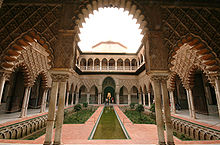
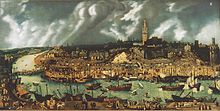 Since
only sailing ships leaving from and returning to the inland port of
Seville could engage in trade with the Spanish Americas, merchants
from Europe and other trade centers needed to go to Seville to
acquire New World trade goods.
Since
only sailing ships leaving from and returning to the inland port of
Seville could engage in trade with the Spanish Americas, merchants
from Europe and other trade centers needed to go to Seville to
acquire New World trade goods.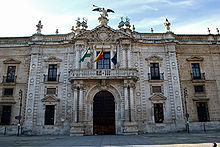
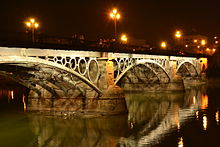
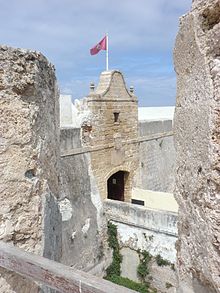 During the Age of Exploration, the city
experienced a renaissance. Christopher Columbus sailed from Cádiz
on his second and fourth voyages and the city later became the
home port of the Spanish treasure fleet. Consequently, it became a
major target of Spain's enemies. The 16th Century saw a series of
failed raids by Barbary corsairs; the greater part of the old town
was consumed in a major fire in 1569; and in April, 1587, a raid
by the Englishman Francis Drake occupied the harbor for three
days, captured six ships, and destroyed 31 others (an event which
became known in England as 'The Singeing of the King of Spain's
Beard'). The attack delayed the sailing of the Spanish Armada by a
year. year.
Inside view of Castillo de Santa
Catalina
During the Age of Exploration, the city
experienced a renaissance. Christopher Columbus sailed from Cádiz
on his second and fourth voyages and the city later became the
home port of the Spanish treasure fleet. Consequently, it became a
major target of Spain's enemies. The 16th Century saw a series of
failed raids by Barbary corsairs; the greater part of the old town
was consumed in a major fire in 1569; and in April, 1587, a raid
by the Englishman Francis Drake occupied the harbor for three
days, captured six ships, and destroyed 31 others (an event which
became known in England as 'The Singeing of the King of Spain's
Beard'). The attack delayed the sailing of the Spanish Armada by a
year. year.
Inside view of Castillo de Santa
Catalina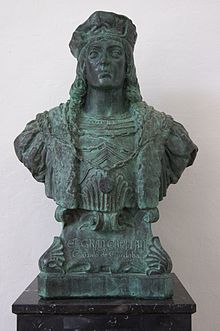
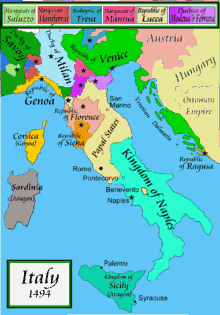 Italy in 1494, when Frederick IV of
Naples took power as the second inheriting son of Ferdinand I of
Naples.
Italy in 1494, when Frederick IV of
Naples took power as the second inheriting son of Ferdinand I of
Naples. 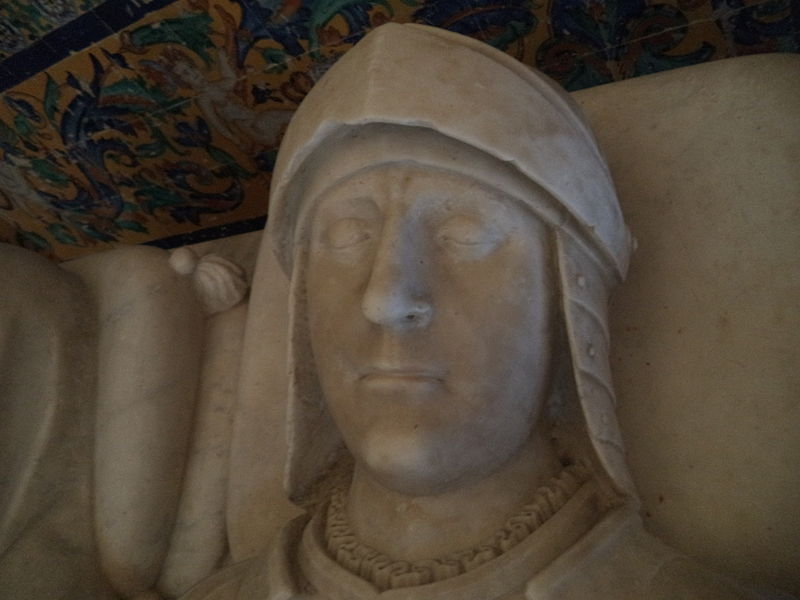
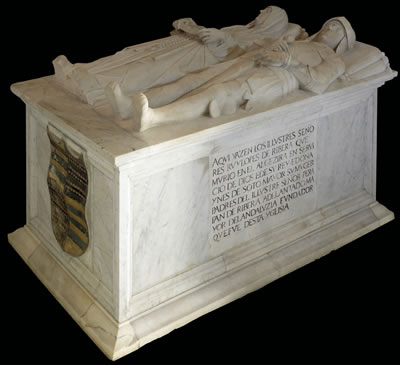
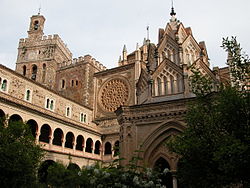
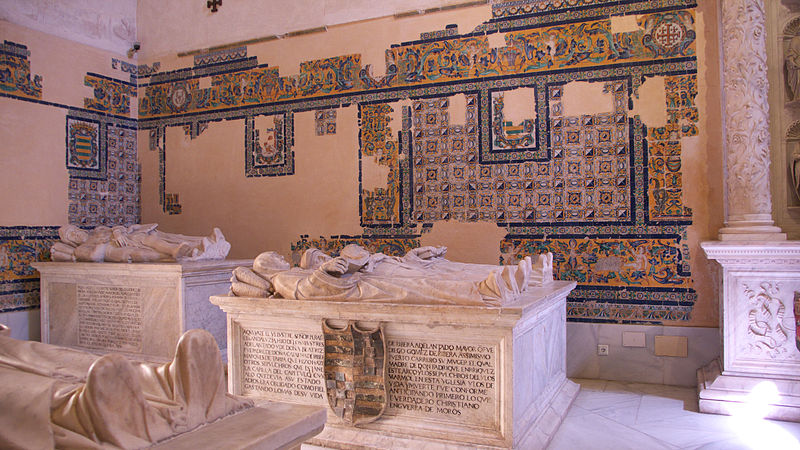 In his will, he left the monastery
11,000 maravedís (The maravedí was the name of various Iberian
coins of gold and then silver between the 11th and 14th centuries
and the name of different Iberian accounting units between the
11th and 19th centuries. The word maravedí comes from marabet or
marabotin, a variety of the gold dinar struck in Spain by, and
named after, the Moorish Almoravids.)
for the construction of four chapels. His widow donated another
10,000 maravedís.
In his will, he left the monastery
11,000 maravedís (The maravedí was the name of various Iberian
coins of gold and then silver between the 11th and 14th centuries
and the name of different Iberian accounting units between the
11th and 19th centuries. The word maravedí comes from marabet or
marabotin, a variety of the gold dinar struck in Spain by, and
named after, the Moorish Almoravids.)
for the construction of four chapels. His widow donated another
10,000 maravedís.
